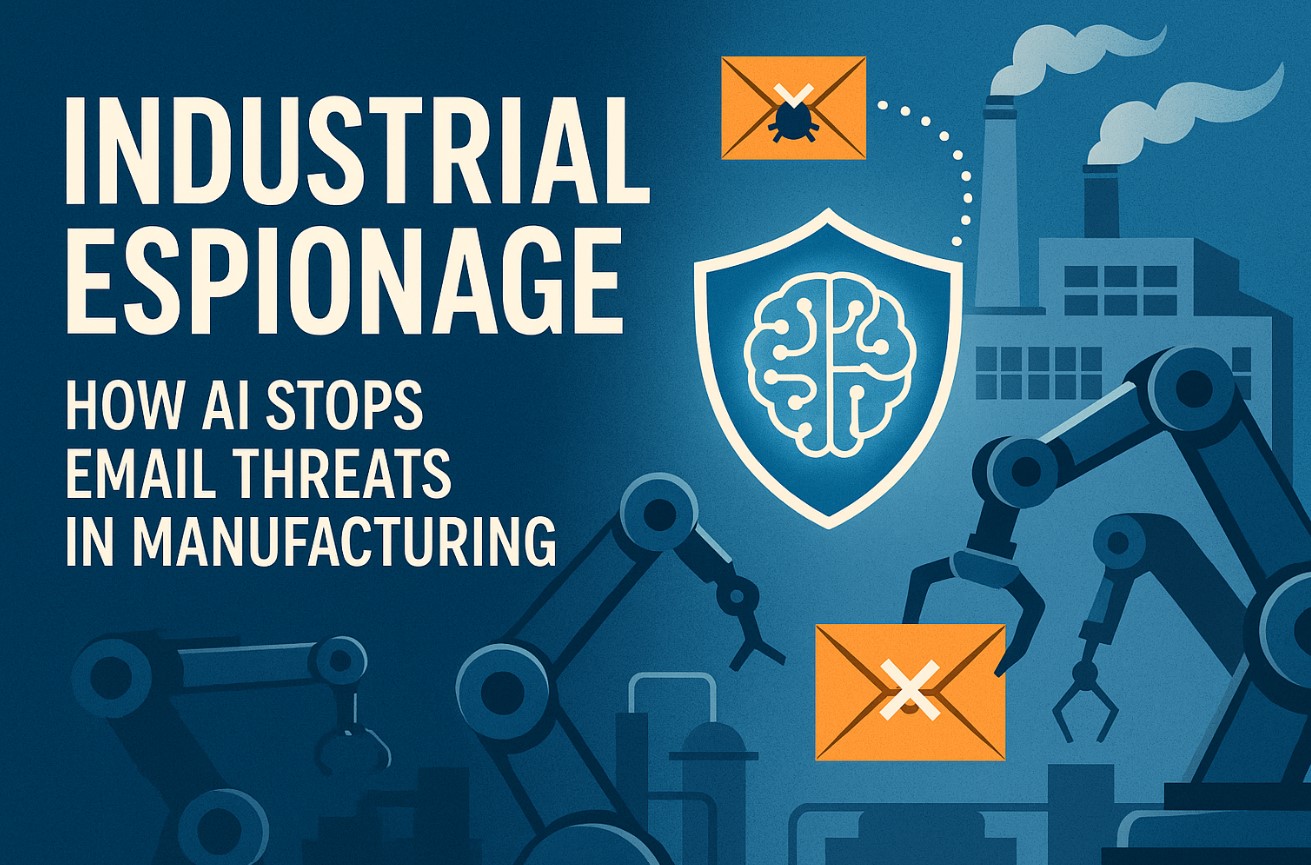
Industrial Espionage: How AI Stops Email Threats in Manufacturing

Manufacturing companies face a surge of highly targeted phishing and fraud attempts aimed at stealing valuable trade secrets, sabotaging operations, or extorting ransom. From clandestine nation-state espionage to everyday cybercrime, threat actors are bombarding manufacturers with scam emails, malicious links, and fake invoices. The stakes couldn't be higher: a single successful phishing email can halt production lines or siphon millions in intellectual property.
This comprehensive guide examines how Artificial Intelligence (AI) is revolutionizing email security for manufacturers – stopping advanced email threats in their tracks and protecting critical industries from industrial espionage.
Executive Summary
Manufacturing is under email attack: The manufacturing industry is one of the most heavily phished sectors, with email now the #1 threat vector for cyberattacks in this space. Sophisticated spear phishing, business email compromise (BEC), and supply chain impersonation scams are on the rise – many with the goal of industrial espionage (stealing trade secrets or sensitive data).
Why manufacturing is targeted: Manufacturers hold valuable intellectual property (designs, formulas, processes) and operate complex supply chains with many entry points. They often rely on legacy systems or have limited cybersecurity staff, making them attractive targets. Disrupting operations via email-borne ransomware or fraud can cost millions in downtime and damages (e.g., a 2023 attack on Clorox caused an estimated $356 million in losses).
Traditional defenses are failing: Legacy email filters and gateways miss today's highly personalized, error-free phishing emails. Attackers use lookalike domains, hijacked vendor accounts, and even AI-generated messages that bypass keyword-based spam filters. Security awareness training helps but isn't foolproof – humans still click. Without advanced protection, many manufacturing firms remain exposed.
AI to the rescue: AI-powered email security brings game-changing capabilities to stop email threats. AI systems use natural language processing to understand email intent and detect social engineering, behavioral analysis to spot anomalies in communication patterns, and even computer vision to catch spoofed logos or fake invoices. These tools recognize the subtle signs of spear phishing, BEC, insider threats, and malware that humans or basic filters miss.
Protecting the entire email threat lifecycle: AI can intercept malicious emails before they hit inboxes, flag compromised internal accounts engaging in suspicious behavior, and even block attempts at data exfiltration. By continuously learning from new attacks worldwide, AI defenses adapt in real time. The result is a dramatic reduction in successful phishing, fraud, and espionage attempts – without flooding security teams with false alarms.
Outcome – safer, smarter manufacturing: For CISOs and IT leaders in manufacturing, AI-driven email security provides peace of mind. It safeguards intellectual property, ensures production continuity, and helps meet compliance mandates by stopping advanced threats automatically. The endgame is a high-trust email environment where legitimate business communications flow freely, but industrial spies and fraudsters are stopped cold.
The Manufacturing Email Threat Landscape in 2025
Email-based attacks against manufacturing organizations have surged in frequency and sophistication. Recent industry research shows a steep climb in phishing and BEC incidents targeting manufacturers over the past year. Manufacturers are under siege from email threats.
Why are manufacturers such prime targets? Several factors make the industry uniquely attractive to cyber adversaries:
Valuable Intellectual Property
Manufacturing companies possess crown jewels like product designs, formulas, engineering plans, and proprietary processes. These trade secrets are precisely what industrial espionage actors seek to steal. Nation-state sponsored hacking groups and competitors are often behind cyber intrusions aiming to exfiltrate CAD drawings, chemical formulas, or manufacturing process data. A successful breach can instantly transfer years of R&D to a rival.
For example, the Council on Foreign Relations noted a 2021 campaign by the Aggah APT group using spear-phishing emails to deliver malware (Warzone RAT) into East Asian manufacturers' networks – a textbook espionage operation to siphon sensitive data.
Complex Supply Chains
Manufacturers rely on broad networks of suppliers, vendors, and contractors. This extended ecosystem creates "endless entry points to exploit" – attackers can phish any link in the chain. A criminal might impersonate a parts supplier, a logistics firm, or an OEM partner via email to gain footholds. With hundreds or thousands of partners and just-in-time communications, it only takes one compromised vendor email to inject a threat downstream.
Operational Technology (OT) Exposure
Unlike office IT networks, manufacturing also has factory-floor systems (ICS/SCADA equipment) that historically weren't designed with security in mind. Threat actors know that phishing an engineer or plant manager's email could eventually help them access OT systems. In the infamous German steel mill cyberattack, for instance, attackers reportedly used phishing emails to gain initial access, leading to a furnace shutdown.
"OT phishing" – targeting staff who bridge IT and industrial control systems – is a growing concern for industrial cybersecurity teams. An unwary click on a malicious email by an HVAC technician or control system engineer can open the door to plant sabotage.
Regulatory and Legacy Challenges
Manufacturers often operate under strict regulatory compliance (e.g., FDA, automotive, or aerospace requirements) and use legacy software that can't be easily patched or replaced. Paradoxically, some compliance policies even force continued use of outdated security systems. Many plants still run old operating systems or unpatched software on production networks. Attackers exploit this by delivering malware via email attachments that leverage known vulnerabilities.
Additionally, outsourced IT and lean staffing leave gaps – a Deloitte study noted many manufacturers lack confidence in their cybersecurity despite increased spending. Limited in-house security expertise means phishing emails may slip through unnoticed or uninvestigated.
High Cost of Downtime
In manufacturing, time literally equals money. A halted assembly line or compromised industrial robot can cost thousands of dollars per minute. Cybercriminals are acutely aware of this urgency. Ransomware gangs in particular prey on manufacturers, knowing that a virus which encrypts production data or disables OT systems puts extreme pressure on the victim to pay up quickly.
As a case in point, in August 2023, cleaning products giant Clorox suffered a cyberattack (speculated to be ransomware) that forced production systems offline. The fallout was widespread product shortages and tens of millions in losses – by November, Clorox disclosed $49 million in remediation costs and sales drop due to the incident. This highlights how a single email-borne attack can have quarter-billion-dollar consequences. Criminals target manufacturers with extortion scams because they know downtime is intolerable and executives will pay large ransoms to restore operations.
Manufacturing presents a "perfect storm" of incentives for email attackers: lucrative data to steal, many possible victims to phish (employees and partners), often porous defenses, and a willingness to pay to make problems go away. It's no surprise that cyber-espionage attackers use spear-phishing emails as their primary intrusion method. Email is the conduit for much of today's industrial espionage and cybercrime.
Common Email Threats Exploiting Manufacturers
Let's break down the most prevalent email-borne threats that manufacturing organizations face, and see how they enable everything from fraud to espionage. Understanding these threat types is the first step in devising an AI-enabled defense strategy.
1. Spear Phishing & Malware Infiltration
Spear phishing refers to highly targeted phishing emails, often tailored to a specific company or even an individual. Attackers invest time in reconnaissance – studying a manufacturing firm's structure, learning employee names and roles, maybe scraping LinkedIn or procurement portals. Then they craft believable messages that masquerade as routine business communications.
For example, an attacker might send an email to a plant engineer that appears to come from a known equipment supplier, asking the engineer to review an attached "maintenance manual" for a CNC machine. In reality, the PDF attachment is laced with malware that, once opened, installs a remote-access trojan (RAT) on the engineer's computer. In one documented campaign, the Pakistan-linked group Aggah did exactly this – compromising WordPress websites and sending emails with links that delivered the Warzone RAT to manufacturing companies in Taiwan and South Korea. The goal was to spy on these companies and possibly steal sensitive data.
In another case, spear-phishers targeted chemical manufacturers by pretending to be a job applicant emailing a resume; the "resume" was malware that gave attackers a foothold in the network.
Unlike generic phishing, spear phishing emails are usually polished and deceptively credible. They often reference real projects, use correct industry jargon, or spoof a legitimate business partner's email address. Notably, modern phishing emails lack the obvious signs of fraud. Today's malicious emails might be grammatically perfect, use the company logo, and address the recipient by name.
For manufacturers, the consequences of one employee being phished can be dire. If the malware includes credential-stealing capabilities, the attackers may capture VPN logins or OT system passwords from that engineer's machine. With stolen credentials, they could pivot deeper – accessing an R&D file server to pilfer blueprints, or jumping to an ICS network segment to disrupt production.
Even without malware, a cleverly written phishing email can trick employees into directly handing over sensitive information. There have been cases of attackers emailing HR staff posing as company executives, requesting copies of all employees' W-2 tax forms (which are then used for identity theft). In a manufacturing context, an attacker might impersonate a VP of Engineering and ask an assistant for the latest design specifications of a prototype product – and the assistant, wanting to be helpful, might send the files before realizing the request was fake.
Spear phishing is a versatile weapon. Whether the objective is espionage (stealing IP) or sabotage (planting malware/ransomware), a well-crafted email to the right person can bypass many security layers. This threat is amplified in manufacturing where not every employee is trained to spot subtle scams, and where specialized staff (like plant engineers) might not expect to be targeted via email.
2. Business Email Compromise (BEC) and CEO Fraud
Another rampant threat is Business Email Compromise (BEC) – essentially, criminals impersonating someone high-up or a trusted partner to deceive employees into sending money or sensitive data. In manufacturing, BEC often takes the form of "CEO fraud" or "fake president" scams targeting the finance department. Attackers either spoof the CEO's email address or actually hack an executive's real email account, then send instructions that appear to come from that leader. Typically, they urgently request a wire transfer or payment related to some business deal.
A notorious example is the case of FACC, an Austrian aerospace manufacturer. In 2016, FACC's finance staff received an email that looked like it came from the CEO, asking them to wire funds for a confidential acquisition project. The request was urgent and came with instructions not to inform others. Believing it to be authentic, an employee transferred roughly €42 million ($47M) to the provided bank account. It turned out to be a scam; the money went straight to the fraudsters. The fallout was severe – FACC's CEO was fired for failing to prevent the incident. This "fake CEO" BEC attack cost the company almost 10% of its annual revenue and serves as a cautionary tale: a single convincing email can upend an entire manufacturing business.
BEC scammers often play on urgency and authority. An email might claim, "We have an emergency situation with a key supplier – I need you to wire $200,000 within 30 minutes, no time for approvals." Employees, trained to follow orders from the CEO or CFO, may comply without second-guessing, especially if the email looks legitimate and pressure is high. In manufacturing companies where large dollar invoices and international transfers are common, such requests might not immediately raise alarms.
Beyond CEO impersonation, attackers also impersonate other trusted parties. They might send BEC emails that appear to come from a supplier or vendor, instructing the manufacturer to update bank account details for future payments. If the manufacturer falls for it, their next payment to that supplier (say, $500,000 for a batch of components) is diverted to the attacker's bank account. This is sometimes called vendor email compromise (VEC).
In one case (August 2024), U.S. chemical manufacturer Orion Engineered Carbons disclosed that an employee was deceived into a series of fraudulent wire transfers totaling about $60 million – likely due to attackers either impersonating a vendor or using a hacked internal account. The incident shows how devastating a successful BEC/VEC attack can be on a manufacturer's finances.
Why do BEC attacks succeed even against diligent companies? Unlike automated spam, BEC emails involve careful human planning. Attackers may spend weeks studying a target organization's executives (via LinkedIn, news, etc.), learning who the key finance people are, what the company's upcoming deals or payments might be (sometimes gleaned from press releases or by phishing lower-level employees for information). They often time their attacks strategically. For instance, they might strike during a quarter-end rush or when a CEO is traveling – times when an urgent payment request via email feels plausible and people are less likely to verbally confirm details.
In FACC's case, the attackers knew enough about a potential acquisition project to craft a believable scenario. In another incident at a European manufacturer, the fraudsters waited until the real CEO was on vacation to send a fake email to finance, counting on the fact that he wasn't reachable.
Crucially, email account takeover can make BEC nearly indistinguishable from legitimate emails. If attackers compromise the actual email account of your CEO or supplier (for example, by stealing credentials via a phishing page), they can send messages from the real mailbox. These come signed with the correct email headers, and often even sit in the ongoing reply chain of an existing conversation. One of the case studies later will describe how hackers in Australia compromised a vendor's account and tricked a manufacturer (Inoteq) into paying a fake invoice – leading to a legal battle where the victim was held responsible despite being defrauded. It underscores that even doing business as usual via email can be risky without verification, when criminals are lurking in inboxes.
3. Supply Chain Impersonation & Vendor Fraud
Manufacturing runs on tight supplier relationships – and attackers know it. Supply chain phishing refers to schemes where criminals exploit the trust between a manufacturer and its vendors, suppliers, or customers by impersonating one party to the other via email. We touched on one aspect of this (vendor BEC), but the problem is broader. Supply chain phishing can involve fake invoices, bogus purchase orders, or even malicious links sent under the guise of routine logistics communications.
Consider a few real-world scenarios that have played out in recent years:
Fake Invoice Fraud (Vendor Impersonation): Hackers register an email domain that looks one letter off from a real supplier's domain (e.g., supplier-co.com vs. the real supplier.com). They then email the accounts payable clerk at the manufacturer with an "updated invoice" for a recent shipment, including new bank account details for payment. Because the email appears to come from the known supplier's billing department (and references a real purchase order number), the clerk pays the invoice. Only later does the actual supplier complain about non-payment – revealing that the money went to the impostor.
A variant is when attackers actually hack the supplier's real email account (as in the Inoteq case) and send an authentic-looking invoice from there. These schemes prey on the routine nature of business communications; an invoice or payment request doesn't seem unusual amid daily operations.
"Long-Game" Supplier Cons: In a remarkably elaborate campaign dubbed "ZipLine," scammers targeted multiple manufacturing firms by first contacting them through the companies' public "Contact Us" web forms. They posed as a potential client with a serious business inquiry. By starting the conversation through the web form, they prompted a legitimate reply email from a salesperson, thereby slipping past email filters (since the initial contact was via the website). Over weeks, the attackers exchanged emails with the company, built trust, even signed fake NDAs. Finally, they sent a payload – a malicious ZIP file, claiming it was product specifications – which when opened installed malware.
This multi-stage social engineering attack cleverly leveraged the company's own outbound email system to bypass technical defenses and exploit human trust. It shows how far attackers will go in supply chain contexts, even exploiting customer-vendor interactions.
Global Scale Tech Supply Chain Fraud: A famous case involved a hacker impersonating Quanta Computer, a legitimate hardware supplier for tech giants like Google and Facebook. Between 2015 and 2017, this fraudster sent fake purchase orders and invoices to Google and Facebook accounting staff for "services" Quanta provided – except the bank accounts were controlled by the criminal. Because Quanta was indeed a real supplier, these large companies didn't catch on immediately. By the time the scheme was uncovered, the tech firms had paid out over $100 million to the impostor. This incident, while not a traditional manufacturer scenario, underscores how even the savviest organizations can be fooled by credible-sounding supplier emails if proper verification processes are lacking.
The outcomes of supply chain email attacks can be devastating. Financially, companies lose money to fraud and rarely recover it (banks often cannot claw back wire transfers after the fact). Operationally, an attacker who slips malware via a supplier email might gain access to internal production systems, leading to sabotage or ransomware. And in terms of intellectual property, supply chain phishing is a common vector for industrial spies to steal design documents. Attackers often send malicious emails that align with normal business routines (quotes, RFQs, shipping notices) because it "masks the threat" amidst genuine communications.
As a result, the manufacturing sector has suffered numerous breaches traced back to a compromised supplier or an impersonated partner email.
One chilling legal precedent from Australia highlights the stakes: In 2024, a West Australian court case (Mobius v. Inoteq) dealt with a situation where Inoteq (the manufacturer) was duped by a hacked vendor email into paying the wrong account. The court ruled that the manufacturer bore the loss – essentially blaming the victim for not detecting the fraud. This sent shockwaves, reinforcing that companies must implement strict verification steps for any financial transaction requests received by email. It's a reminder that technology and policy must work hand-in-hand to counter supply chain threats.
4. Phishing-Enabled Ransomware & Disruption
Not all email attacks steal money or data immediately; some plant the seeds for ransomware or other disruptive attacks. Manufacturing has increasingly become a target of ransomware groups, who often gain their initial foothold through phishing emails carrying malicious attachments or links. The pattern is familiar: an unsuspecting employee clicks a link in an email (perhaps a fake shipping schedule or an HR document) and unknowingly runs a piece of malware. That malware quietly spreads through the IT network – and sometimes into OT networks – then at a preset time it encrypts critical files and systems, bringing factory operations to a grinding halt.
We've already mentioned the Clorox incident (2023) and the Colonial Pipeline attack (2021) as examples of how quickly a cyber incident can snowball into a real-world crisis. In manufacturing, another emblematic case was Norsk Hydro (2019), one of the world's largest aluminum producers.
Norsk Hydro was hit by a ransomware strain called LockerGoga, which forced several plants to switch to manual operations and impacted global aluminum output. Initial investigations pointed to phishing as the likely entry point for the attackers (though the exact phishing email wasn't found). LockerGoga was particularly nasty: it wasn't even designed to allow the victim to pay a ransom easily – it simply aimed to cripple systems, suggesting a possible sabotage motive beyond extortion. Norsk Hydro refused to pay and spent weeks recovering, at an estimated cost of over $70 million in losses and recovery expenses. This demonstrates how a single compromised email can cascade into a full-blown industrial shutdown.
Modern ransomware attackers have adopted techniques that blend traditional hacking with persistent phishing. They might phish for credentials, then spend weeks quietly elevating privileges and mapping out industrial networks before triggering the encryption. Some use phishing to deploy initial-stage malware (like TrickBot or QakBot), which then hands off to ransomware. Others perform "double extortion" – first stealing sensitive files via backdoor access and later encrypting systems, so they can demand payment both to unlock systems and not to leak stolen data. For manufacturers, this could mean proprietary formulas or client design files end up on leak sites if ransoms aren't paid.
Operational disruptions caused by email-based intrusions aren't limited to ransomware either. Attackers could use phishing to install spyware that quietly alters production data (sabotage by stealth), or to gain control of a critical safety system. For instance, some security researchers have pointed out scenarios where phishing an HVAC contractor's email could let attackers drop malware into a smart HVAC system of a plant, messing with environmental controls needed for sensitive manufacturing processes. While hypothetical, these possibilities underscore that email is often the first domino knocked over in a chain leading to physical consequences.
5. Insider Threats and Email Compromise from Within
While many threats come from external attackers, manufacturing firms also have to consider insider threats – both malicious insiders and unwitting ones. Email plays a role here as well.
A malicious insider (e.g., a disgruntled employee or one bribed by competitors) might use corporate email to exfiltrate confidential information. For example, an employee could email out hundreds of pages of design documents to their personal Gmail or to a competitor's address. They might also plant malware via email by abusing internal trust (sending infected attachments to colleagues). In one real case, engineers at a multinational car manufacturer were caught emailing proprietary blueprints to contacts in a foreign country as part of an IP theft scheme. Such insider espionage is a serious concern in high-value manufacturing segments like aerospace, automotive, and electronics.
On the other side are the unwitting insiders – employees whose accounts have been compromised by attackers. Once an external phisher has stolen someone's email login (through any of the tactics discussed earlier), the attacker can literally become an "insider" using that account. They may then send further phishing emails from the trusted internal address, phish other employees, or quietly harvest information from email archives. This lateral movement is dangerous because it's much harder to detect; the emails and activities originate from a legitimate account that has the right access privileges.
Insider-related email threats in manufacturing can lead to industrial espionage just as surely as external attacks. A particularly striking scenario occurred in 2021, when a Chinese state-sponsored group was found targeting employees at a European solar panel manufacturer. They phished a few insiders, used those accounts to access sensitive R&D info, and then had the compromised accounts email out that data in small trickles disguised as normal correspondence. It went unnoticed for months, effectively turning the company's own email system into a tool of espionage.
Even beyond intentional malfeasance, human error via email can cause insider risk. Think of a well-meaning employee who, after failing to spot a phishing email, follows the fraudulent instructions – they might change a bank account number as "requested" or send sensitive files to an outsider. From a consequences perspective, the damage is done by an insider action, albeit one tricked by external forces.
Manufacturing organizations must monitor email not only for external threats coming in, but also for signals of internal compromise or misuse. An employee account that suddenly starts emailing out large attachments at odd hours, or a normally quiet user who begins communicating with competitors or unfamiliar addresses, could indicate an insider issue. Historically, such subtle signs were hard to catch without infringing on privacy or hiring large security teams. This is exactly where AI-based monitoring (which we'll discuss later) shines – by learning normal patterns and flagging anomalous behavior that could indicate an insider threat, all without reading actual content if configured properly.
We have surveyed the major email threat scenarios plaguing manufacturers: spear phishing, BEC, supply chain fraud, ransomware infiltration, and insider-driven leaks. In many incidents, multiple threat types converge (for instance, a phishing attack leads to an insider account takeover, which is then used for BEC fraud). The email threat lifecycle can be complex and multi-stage. Next, we'll examine why traditional defenses struggle against these modern attacks, and then delve into how AI-powered security can counter them effectively at each stage.
Why Traditional Email Security Falls Short in Manufacturing
Given the onslaught of email threats, one might ask: aren't companies using email security gateways, spam filters, and training to handle this? Yes – and attackers are outsmarting them. Traditional email security often relies on a mix of known-bad signatures, blocklists of malicious senders, and simplistic keyword-based rules. These legacy approaches, while useful against generic spam and known malware, fail to detect the nuanced, novel tactics used in modern industrial espionage campaigns.
Some key limitations of traditional email defenses are:
Static Rules vs. Dynamic Humans: Rule-based filters look for specific phrases ("Nigerian prince," "lottery winning") or known malicious attachments. But today's attackers craft emails unique to each target, often containing no obvious bad keywords or using innocuous-looking content. A spear-phishing email may have a benign PDF with a zero-day exploit – no signature will catch it because it's never been seen before. Traditional tools simply cannot keep up with the dynamic, tailored nature of these attacks. As one security expert put it, attackers now send "polished, error-free messages that…fail to arouse employee suspicion" and slip past the old filters.
Impersonation Blind Spots: Manufacturing organizations frequently get emails from many partners and suppliers. Legacy spam filters struggle with spoofed or lookalike domains that impersonate these trusted senders. For instance, a filter might allow any email from "@trusted-supplier.com" – but what if the attacker uses "[email protected]" (notice the subtle typo)? Many gateways won't flag that. Similarly, if an attacker compromises a real supplier's account, their malicious email has all the correct authentication (SPF/DKIM) and appears totally legitimate. Traditional solutions can't easily decide that an email from a real partner's account is actually malicious in intent.
Lack of Contextual Understanding: Old-school email security looks at each email in isolation. It doesn't correlate with past communications or typical behavior. This is a huge weakness. For example, if John in procurement never emails the CEO, and one day "John" sends the CEO a message with an urgent request, that's unusual. Human beings might catch that if they're vigilant, but an automated rule won't. Attackers exploit this lack of context – they insert themselves into existing conversations or send just-plausible-enough requests that a busy recipient might gloss over. Without context awareness, many subtle phishing emails appear benign.
Alert Overload and Missed Signals: Traditional systems, when tuned strictly, tend to either let threats through or generate too many false alerts. Manufacturing IT teams, which are often small, can't afford to investigate a hundred spam alerts a day hoping to find the one real phish. In practice, filters are set to avoid interrupting business (false positives), which unfortunately means they let borderline emails through. Some companies deploy basic data loss prevention (DLP) rules to catch certain keywords or large attachments going out, but these generate noise (e.g., flagging even harmless sends) and can be circumvented by attackers using encryption or trickery. The net effect is that security teams drown in low-value alerts and may miss the real threats or respond too late.
Delayed Detection: Many legacy email security tools operate at the gateway and don't have visibility once an email is delivered. If an email later proves malicious (say a link in it becomes active with malware after a few hours, a common tactic), traditional defenses might not catch it in time. Attackers exploit this by using delayed payloads and one-time links. Manufacturers who rely purely on perimeter email gateways lack the ability to continuously monitor and retract harmful emails post-delivery.
These gaps have real consequences. The manufacturing sector in particular has many firms that still trust the default filters in services like Microsoft 365 or Google Workspace, which don't block advanced social engineering. As StrongestLayer's research team notes, many AI-generated phishing emails sail past Microsoft's default protections. The reality is that motivated attackers innovate faster than rule-based defenses can update.
Another challenge is the human factor: regular training helps, but employees can't be expected to perfectly spot every hoax. Especially when emails arrive that appear internally generated or come through legitimate channels (recall the "Contact Us" form example), even a savvy user can be fooled.
Attackers intentionally target new or non-technical staff with things like fake HR emails ("Please review the updated safety protocol attached") which people feel obliged to open. Manufacturers also employ many people in production and engineering roles who may not be cybersecurity experts – it's unfair and unrealistic to pin the entire defense on them. Thus, a more intelligent filtering and monitoring system is needed – one that can catch what humans miss and even what humans might fall for.
This is where AI-driven email security enters the picture. By using machine learning and advanced analysis techniques, AI-based solutions overcome many of the above limitations. They understand context, adapt to new threats, and ease the burden on humans. In the next section, we'll dive into how exactly AI works to detect and stop malicious emails, and how it addresses the shortcomings of traditional tools.
AI-Powered Email Security: A Game Changer for Industrial Threats
Imagine an email defense system that learns the normal patterns of your manufacturing business – who typically communicates with whom, what a usual purchase order looks like, how your CEO normally writes – and then uses that knowledge to flag anything out of the ordinary. Picture a filter that doesn't rely on pre-known bad signatures, but can sniff out the intent behind an email – catching subtle fraud attempts, spotting a malicious link even if it's brand new, and recognizing when a trusted account has been hijacked by noticing behavioral shifts.
This is what AI-powered email security brings to the table. It's a fundamentally different approach, leveraging machine intelligence to detect threats that evade every static rule.
Let's break down the key AI capabilities that specifically help stop email threats in manufacturing:
Natural Language Processing (NLP) for Intent Analysis
AI email security platforms use Natural Language Processing to literally "read" and interpret the content of emails much like a human would – but with an unfailing eye for certain cues. Instead of just scanning for keywords, advanced NLP models analyze the tone, wording, and structure of each message to determine if something feels "off" or potentially harmful.
For example, NLP can identify if an email that claims to be a casual note from a colleague is too formal or terse compared to that person's usual style. It can flag if an email's language exhibits known patterns of phishing – such as an unusual urgency ("as soon as possible, end of day!"), or psychologically manipulative phrasing trying to create panic or secrecy. In manufacturing contexts, NLP might catch subtle signs like an email referencing a project code-name incorrectly, or using terminology a real supplier wouldn't use. These are the kinds of subtleties that traditional filters miss.
AI models are trained on massive datasets of both legitimate and phishing emails. They learn to recognize the hallmarks of social engineering. One AI might notice: "This email is insisting on an urgent wire transfer and uses financial language, but the sender usually never discusses finances – that's a red flag." Another might spot that an email to an engineer about "new safety guidelines" has odd phrasing that doesn't match previous genuine safety memos. Essentially, NLP-driven analysis provides a content-aware filter that looks at meaning and intent, not just known bad phrases.
StrongestLayer's platform, for instance, touts that its AI "understands intent – not just keywords – so it catches socially engineered threats traditional filters miss." In practice, this could mean detecting that an email ostensibly from a CEO is actually trying to pressure an employee into a careless action (like bypassing standard procedures), which is a common tactic in BEC scams. The AI sees the psychological manipulation in the text and flags it.
In one scenario, a manufacturer's AI security flagged an email from a vendor because the tone was strangely pushy and contained subtle grammatical errors inconsistent with that vendor's past emails. It turned out the vendor's account had been hacked and an attacker was sending fraudulent requests. The AI's language model was able to catch the discrepancy when humans likely would not. This highlights how NLP adds a layer of judgment akin to an expert human reading every email – but at machine speed and scale.
Behavioral Anomaly Detection
Perhaps the most powerful aspect of AI email security is its ability to learn "normal" behavior and then detect anomalies. Machine learning algorithms crunch vast amounts of data about communication patterns within the company and with external partners. Over time, the AI builds a baseline: who usually emails whom, at what times, about what topics, with what typical language and attachments, etc.
With this baseline, the AI can spot when something deviates significantly. In manufacturing settings, examples might include:
- An employee account that suddenly starts emailing a recipient it has never contacted before, especially one outside the organization. If John in engineering has never emailed anyone in the finance department, an email from John to the CFO asking for a payment will stick out like a sore thumb to the AI. Deviation = alert.
- Unusual sending times or volumes. Say an employee typically sends 5 emails a day, always during work hours. If that account suddenly blasts 50 emails at 2 AM to external addresses, it's likely compromised (could be a spam bot or a malicious actor exfiltrating data). The AI will catch that immediately.
- Changes in email content patterns. For instance, a plant manager's account that normally discusses maintenance schedules now is emailing legal contracts to someone – that's weird. Or a procurement officer who never interacts with the CEO suddenly sends an "urgent request" email to the CEO. These are exactly the kind of things humans might not know (because no single person knows everyone's patterns), but an AI system monitoring all communications can recognize what's out of character.
StrongestLayer's research gives a great example: "If 'Jane in Finance' never emails the CEO directly, an email from Jane requesting funds for an acquisition raises a flag." This kind of anomaly detection would thwart many BEC scams. In the FACC case, had an AI been monitoring, it might have flagged the CEO's email asking for a huge transfer as uncharacteristic and required extra verification, potentially preventing the $42M loss.
Behavior-based AI can also detect anomalies in vendor behavior. If a normally very professional supplier suddenly starts sending invoices with slight typos in bank info, or a materials provider that typically ships via one port emails about a different shipping method, these could be signs of impersonation or compromise. In one real instance, an AI detected that a vendor's invoicing emails started coming from a new domain and had a PDF attachment structure different from the past dozen invoices – it turned out the vendor's email was hacked and attackers were trying to slip in fraudulent invoices. The anomaly was caught and alerted.
In essence, AI acts like a vigilant security analyst who knows the typical communications graph of the company and rings the alarm bell the moment something doesn't fit. This is incredibly effective against unknown threats because it doesn't rely on the threat having been seen elsewhere – it just cares that the activity is unusual for your environment. Considering that 77% of spear-phishing attacks in one study were unique (targeted to one organization) and thus not in any threat feed, having this anomaly-based approach is critical.
Computer Vision and Attachment Analysis
Email attacks often involve more than text – they can include images, logos, and document attachments. Modern AI security tools incorporate elements of computer vision to examine the visual content of emails and attachments, as well as advanced file analysis techniques to dissect attachments.
Brand Logo Detection: Phishing emails frequently copy company logos or create convincing replicas of login pages. AI can be trained to recognize known brand logos or common phishing kit designs inside an email. For instance, if an email claiming to be from Microsoft includes the Microsoft logo, a computer vision model can verify if that logo is the exact pixel-perfect official one or an altered version often seen in phishing kits. It can also cross-check if an email coming from outside the company is using the company's own logo or name – a likely sign of impersonation. In a manufacturing setting, this could flag an email that uses, say, the Siemens or Rockwell Automation logo in an attempt to trick an engineer into thinking it's an official SCADA update notification.
Image-based Phishing Detection: Some attackers bypass text-based filters by embedding the phishing message as an image (e.g., a picture of a fake invoice or a screenshot telling the user to reset a password). AI vision models can actually "read" text within images (using OCR – optical character recognition) and apply the same NLP analysis on that extracted text. They can also identify suspicious characteristics – like images that are slightly obfuscated to fool basic spam filters. Cisco Talos researchers noted that AI vision can catch things like bogus QR codes or deepfake profile photos in emails.
Attachment Sandboxing with AI: When it comes to attachments (documents, PDFs, spreadsheets), AI-driven solutions often combine static analysis with dynamic sandboxing. Static analysis uses machine learning to scan the file's structure for signs of malicious code or macros. Dynamic analysis means the AI detonates the attachment in a virtual safe environment to see what it does. What's novel is using AI to quickly decide if an attachment's behavior is malicious or not, even if it's a new zero-day exploit. Because AI can generalize from seeing patterns of malicious behavior (writing to certain registry keys, spawning hidden processes, etc.), it doesn't need a specific virus signature to declare "this attachment is doing something bad."
For example, an AI system might intercept an email to a factory manager with an Excel file purporting to be a parts list. The Excel tries to run PowerShell to download a file – the AI recognizes this behavior as highly indicative of malware, so it blocks the email entirely. All of this happens in seconds, protecting the user before they ever see the email.
At scale, AI can evaluate URLs and links in emails too. Detecting that the landing page is a fake login page (perhaps by comparing its visuals to known login pages, or by seeing that it's harvesting input fields), and then either quarantine the email or rewrite the URL to something inert. Traditional filters might only blacklist known bad URLs, but an AI can say "this URL on a brand-new domain is asking for password – very suspicious – block it." This is crucial because many phishing sites are one-day domains that wouldn't be on any blacklist yet.
By bringing in computer vision and advanced attachment analysis, AI security adds a multi-sensory ability to email scanning: it "sees" images and "understands" files, not just plain text. This covers avenues that attackers hoped would evade text-only defenses.
Threat Intelligence Integration and Continuous Learning
AI email defenses don't operate in isolation; they get smarter by learning from attacks across all protected organizations. When one company's AI system detects a new phishing lure or malware attachment, that information (scrubbed of specifics) can be fed into global threat intelligence that benefits others. This network effect is very powerful in an AI-driven solution.
For instance, imagine attackers registering a new domain like micros0ft-support.com to target multiple companies with a credential-stealing email. If one AI system catches an email from that domain and flags it as phishing, it can share that feature to the broader model. The next time any client of the platform sees an email from the same lookalike domain, it's blocked immediately. The AI basically learns from each attack and disseminates that learning in near-real-time.
StrongestLayer notes that modern AI platforms "continuously update their knowledge with global intelligence feeds. If a newly registered domain starts impersonating a freight company, the AI can correlate it with threat databases… the system learns from attacks on other companies." In manufacturing, this means if one firm is targeted with a fake DHL shipping notice malware, other firms' AI might preemptively know to distrust similar emails. It shortens the zero-day window dramatically.
Moreover, AI systems continuously retrain on new data. Unlike a rule set that might be updated monthly, an AI model can be updated daily or even on-the-fly. They also can incorporate feedback: if an employee reports a phishing email that slipped through, the system takes that as new training data to adjust its algorithms (closing that gap for the future). Likewise, if a certain alert turns out to be benign, the AI refines itself to reduce false alarms. This continuous learning loop means the longer you use AI email security, the better it gets, both for your company and the community of users.
Another aspect is how AI can adapt to attacker adaptations. We're essentially in an arms race where attackers may start using AI themselves (like AI-generated phishing content). Defensive AI can counter by recognizing AI-written text patterns or detecting deepfake spear-phishing calls, etc. Already, some AI email systems use deep learning to distinguish human-written vs. machine-generated emails by analyzing subtleties in phrasing and consistency. This is an evolving area, but an important one as we head into 2025 where AI vs. AI battles in phishing will become more common.
AI-powered email security is adaptive, context-aware, and fast. It brings a suite of intelligent techniques – NLP, behavioral modeling, vision, threat intel – to bear against email threats. In the next section, we'll see how these capabilities come together during an actual email threat scenario in a manufacturing environment, essentially walking through the "email threat lifecycle" and where AI intervenes at each step.
The Email Threat Lifecycle: How AI Intervenes at Every Stage
A targeted email attack on a manufacturing company typically unfolds in stages: from initial reconnaissance by the attacker, to the phishing email delivery, to potential compromise and lateral movement, and finally to the attacker's end goal (be it data theft, fraud, or disruption). Each stage presents opportunities for detection and defense. A well-designed AI email security solution will have multiple hooks into this kill chain, aiming to break it at the earliest possible point. Let's illustrate this with a hypothetical (but realistic) scenario and highlight how AI-driven defenses can stop the attack in its tracks.
Stage 1 – Reconnaissance & Targeting
An attacker sets sights on a manufacturing firm (let's call it "Acme Corp"). They gather publicly available info: names of executives, suppliers, recent news (maybe Acme is acquiring a smaller company). The attacker decides to target the CFO with a fake email about that acquisition.
At this stage, AI Pre-Attack Intelligence can sometimes raise an early flag – for example, some advanced systems monitor for lookalike domains being registered (e.g., acme-finance.com similar to the real acmefinance.com). If such threat intel is integrated, Acme's security team might get a heads-up that their brand or partners are being spoofed externally. While this isn't an email defense per se, it shows how AI can assist even before the phishing email arrives, by detecting attacker preparatory actions.
Stage 2 – Phishing Email Delivery
The attacker sends the carefully crafted phishing email to Acme's CFO, spoofing the CEO's address and urging the CFO to wire money for the "acquisition" by end of day. This is the crucial point where AI email security ideally intercepts the threat. The AI analyzes the email in real time as it comes through the gateway: it checks the sender's details (does the domain and address match the CEO's known accounts? If not, big red flag). It evaluates the content via NLP – the email is pressing for a financial transaction with urgency, which matches a known BEC pattern. It compares to behavior: the CEO rarely, if ever, asks the CFO for a wire via email, especially not without other staff CC'd.
All these factors combine into a risk score that likely exceeds the threshold. The result? The email is quarantined or tagged as suspicious. The CFO either never sees it, or it comes with a bold warning banner inserted by the AI system ("This message is suspicious: possible impersonation"). In our scenario, say the CFO does not act on it thanks to the warning – Stage 2 is where the attack fails, which is the best outcome.
But let's assume in an alternate scenario that the phishing was extremely stealthy and got through (perhaps the attacker actually compromised the CEO's real email account, making detection harder). Now the attack moves to stage 3.
Stage 3 – Account Compromise and Spread
The CFO, believing the email was real, initiates the wire. Additionally, suppose the phishing email had a malicious link that the CFO clicked, allowing the attacker to drop a backdoor on the CFO's system or harvest their login cookies. Now the attacker has access to the CFO's email account and possibly their credentials. This is a critical failure point – but AI can still salvage the situation by detecting the resulting anomalous behavior.
The attacker, using the CFO's account, might try to email the accounting department to authorize an unusual payment, or they start forwarding copies of all the CFO's emails to an external address. An AI system monitoring internal email patterns would quickly flag this: the CFO's account is suddenly doing things it never did before (like massive forwarding rules, or emailing new recipients with sensitive data). Immediately, the security team is alerted and/or the AI triggers an automated response like locking the account or asking for re-authentication (if integrated with identity systems).
Even post-compromise, AI can contain the damage by stopping lateral phishing – e.g., preventing the attacker from using the CFO's account to phish others internally ("I'm the CFO, download this file…" which some employees might obey). The anomaly detection kicks in and blocks those internal phishing attempts or marks them as high-risk.
Stage 4 – Attack Progression (Lateral Movement or Exfiltration)
Suppose the attacker's goal was to steal blueprints rather than money. With the CFO's email access, they pivot – they send spear phishing emails from the CFO's account to a few engineers, asking them to send the "latest design files for project X" for a sudden review. Normally, engineers might comply if the request seems legit. But the AI, again, sees this as out-of-pattern: Why is the CFO emailing engineers about design files? It could mark those emails as suspicious internally or alert the engineers with a training prompt ("This request is unusual").
If an engineer still sends files, AI could even catch that in DLP – perhaps recognizing that those CAD file attachments are sensitive and that the recipient (which might actually be an external address disguised or CC'd) is not authorized. At this stage, AI can function as an internal tripwire, detecting the exfiltration of data via email. It might block the email with attachments from leaving the company, or at least alert security ("Engineer is sending confidential drawings externally, unusual activity").
Similarly, if the attacker deploys ransomware at this stage, AI-assisted endpoint email analysis might notice an outbreak of strange file extensions or multiple accounts sending out weird messages (some ransomware tries to email other users). AI systems like anomaly detectors can sometimes pick up the early signals of a ransomware detonation by noticing a flurry of abnormal events in email or network traffic, prompting a swift quarantine of affected systems.
Stage 5 – Attack Detection & Response
Ideally, with AI having raised alarms at one or multiple points, the security team is now actively involved. AI doesn't replace humans – but it augments them by handling the grunt work of detection and even initial response. By the time a human analyst looks, the AI may have already quarantined emails, locked accounts, or blocked data flows as per preset policies. The analysts can then confirm the threat, clean affected systems, and do a post-mortem with far less damage done. In contrast, without AI, the attack might only be noticed when, say, the $60M wire transfer can't be recalled or when systems start locking up from ransomware – i.e., when it's too late.
To visualize this lifecycle: think of the Swiss cheese model of defense – multiple layers with holes, but aligned differently so that a threat piercing one layer might be stopped by the next. AI adds several intelligent layers that dramatically increase the chance of catching the threat early. It's proactive at the gateway (blocking phishing delivery), vigilant inside (monitoring account behavior), and data-aware at exit points (preventing theft). The email threat lifecycle is thus disrupted at multiple junctures:
- Pre-delivery: malicious email identified and blocked (ideal)
- Post-delivery, pre-compromise: user warned, they report it or ignore it
- Post-compromise: unusual activity detected, account access cut off
- Internal spread: odd internal emails flagged, blocking lateral phishing
- Data exfiltration: sensitive attachment flagged, stopped from sending
- Final impact: if ransomware triggers, automated playbooks isolate affected systems (some AI email solutions integrate with endpoint or SOAR systems for this)
Not every attack will involve all stages, but this framework shows how AI-powered defenses create resilience throughout an attack's progression, not just at the perimeter. This is especially useful in manufacturing where, for example, an IT network compromise might be contained before it jumps to OT, or a financial fraud can be halted before money leaves the account.
Now that we've seen how AI can thwart email attacks in action, let's consider what this means for manufacturing leaders in practical terms – the tangible benefits and outcomes of adopting AI email security.
Benefits of AI Email Security for Manufacturing Leaders
For CISOs, IT directors, and compliance managers in the manufacturing sector, deploying AI-driven email security isn't just a technical upgrade – it's a strategic move that directly supports business resilience, safety, and regulatory compliance. Here are the key benefits and outcomes these leaders can expect:
Protection of Intellectual Property: By stopping spear phishing and email-borne intrusions, AI security guards the blueprints, formulas, and proprietary process information that give manufacturers their competitive edge. It dramatically reduces the risk of industrial espionage via email. In effect, AI acts as a sentinel for your trade secrets – preventing that stealthy data grab in the middle of the night or the unauthorized forwarding of CAD files. This helps manufacturers avoid the incalculable loss of IP to competitors or foreign adversaries.
Financial Fraud Prevention: AI's keen eye for BEC and impersonation scams means finance teams are far less likely to be duped. The system will flag or block those fraudulent wire requests and fake invoices that have cost manufacturers millions. This not only saves money directly but also preserves trust with suppliers and executives. CFOs can breathe easier knowing there's an automated watchdog catching the subtle cues of a fraud attempt that a busy team member might miss. Avoiding even one $1M phishing-induced loss easily justifies the investment in AI email protection.
Operational Continuity & Safety: With ransomware and destructive malware being thwarted at the email entry point, the odds of a production-stopping cyber incident drop significantly. That translates to less downtime and more reliable operations. For critical manufacturing (e.g., pharmaceutical or automotive), it also means improved safety – preventing scenarios where cyberattacks could cause equipment malfunctions or product quality issues. Business continuity plans for many manufacturers now include strengthening email security, since it's often the front line of defense against disruptions.
Reduced Security Workload & Faster Response: AI email security can drastically cut down the volume of false positives and spam that IT teams have to sift through. By accurately distinguishing benign from malicious, it lets your limited security staff focus on real threats. When an incident does occur, the AI often has already contained parts of it (e.g., quarantined emails, locked accounts), so responders can clean up faster. Some organizations report that AI-driven filtering reduced their phishing investigation workload by over 80%, freeing analysts to tackle other critical tasks. Essentially, AI is like adding an army of tireless junior analysts that work 24/7, without the hefty headcount cost.
Enhanced Compliance Posture: Many manufacturing sectors are subject to cybersecurity regulations and standards – whether it's ISO 27001, NIST CSF, CMMC (for defense contractors), or industry-specific requirements. AI-based email security helps demonstrate compliance with controls around threat protection, incident detection, and data loss prevention. For example, CMMC (Cybersecurity Maturity Model Certification) mandates advanced email protections for DoD supply chain members – an AI solution can fulfill some of the highest-level requirements by leveraging behavior monitoring and anomaly detection. Auditors and customers increasingly ask, "What are you doing about phishing and BEC?" Having an AI solution in place provides a strong answer and can reduce insurance premiums or qualify a manufacturer for contracts that require robust cybersecurity.
Adaptability to Evolving Threats: Manufacturing processes might change with Industry 4.0, more IoT on the shop floor, etc., and attackers will adapt too (we might see more AI-generated phishing targeting those new systems). AI email security is inherently more adaptable than static tools. It will learn new patterns as your organization evolves and as threats evolve. This future-proofs your email defense to a large extent. For instance, if attackers start using deepfake audio or video in social engineering, AI can potentially incorporate deepfake detection modules. We've already seen early versions of AI catching AI-generated phishing content – a necessary evolution as generative AI could drastically increase phishing volume. By investing in AI security, manufacturing leaders are staying ahead of the curve, rather than playing catch-up.
Preservation of Trust and Reputation: Manufacturers operate on tight relationships – with clients, with suppliers, with regulators. A breach or large fraud can erode trust and damage the brand (imagine having to tell your big automotive customer that you leaked their designs, or informing investors that a hacker stole millions via email). By preventing these incidents, AI helps maintain your company's hard-earned reputation for reliability and security. It also shows your partners that you take protecting the shared supply chain seriously. In some industries, being known as "the company that got hacked" can lead to lost business; AI security is a proactive measure to avoid that fate.
Seamless Integration and User Transparency: Modern AI email security solutions (including StrongestLayer's) often integrate via API at the email platform level, meaning they don't require complex network changes or hardware appliances. Deployment can be very quick (often a cloud-to-cloud hookup with Office 365 or Gmail that is done in under an hour). For end-users, these systems work mostly behind the scenes – they might occasionally see a warning banner or have a simulation email for training, but otherwise, business email flow isn't hindered. There's no need for employees to constantly use special quarantine portals or deal with excessive email delays. This low friction deployment is a win for IT: high security gain with minimal disruption to workflows, an important factor in manufacturing environments that prize efficiency.
AI-powered email security provides manufacturing security leaders with peace of mind and measurable risk reduction. It's not just about stopping spam; it's about safeguarding the very core of the business – the innovation, the finances, the operations. By catching what others miss, AI creates a safer digital environment that supports the strategic goals of the company (whether that's hitting production targets or expanding into new markets securely).
Final Thoughts: Building a Resilient Manufacturing Future with AI Security
Industrial espionage and email-borne cyber threats aren't going away – in fact, they're growing more advanced by the day. Manufacturing organizations find themselves in the crosshairs of attackers ranging from run-of-the-mill scammers to sophisticated nation-state hackers. In this high-stakes context, relying on yesterday's security approaches is a risk no forward-thinking manufacturing executive can afford. AI-powered email security has emerged as a critical ally in the fight, bringing intelligence, speed, and adaptability that align perfectly with the needs of modern manufacturing.
By deploying AI-driven defenses, manufacturers can transform email from the "weakest link" back into a reliable business tool. Instead of dreading the next phishing test or actual attack, companies gain confidence that malicious emails will be caught and neutralized in real time. And if one ever slips through, the system will detect the anomaly and limit the blast radius. This is the kind of robust, layered defense that high-trust organizations (and their stakeholders) demand.
The tone across StrongestLayer's customer base is optimistic: when human talent and AI technology work hand-in-hand, even the most creative cyber threats can be thwarted. Phishing may never be 100% eradicated, but its success rate can be driven so low that attackers move on to easier prey. Manufacturers who embrace AI email security are effectively saying to attackers, "Not on our watch – find another target."
As you bolster your company's security posture, remember that the journey doesn't stop at technology. Continue reinforcing a security-aware culture, update your incident response plans, and tighten process controls (like verification of payments). AI will amplify all those efforts. The result will be a manufacturing enterprise that not only innovates and delivers for its customers, but does so with security woven into its DNA – a true competitive advantage in the digital age.
Frequently Asked Questions (FAQs)
Q1: What is industrial espionage in manufacturing?
Industrial espionage refers to the theft or compromise of proprietary information, designs, or production data. In manufacturing, this often involves phishing emails or insider threats targeting sensitive engineering data, supplier credentials, or intellectual property.
Q2: How do email-based attacks enable industrial espionage?
Attackers often use spear phishing or business email compromise (BEC) to infiltrate corporate email systems. Once inside, they can steal sensitive data, redirect payments, or plant malware for long-term surveillance.
Q3: What role does AI play in stopping manufacturing email threats?
AI analyzes behavioral, contextual, and linguistic patterns in real time to detect suspicious messages that traditional filters miss. It spots anomalies in sender behavior, tone, metadata, and content — stopping targeted phishing before it reaches employees.
Q4: How is AI different from traditional email security tools?
Traditional tools rely on static signatures or rule-based filters. AI email defense (like StrongestLayer TRACE) learns from user behavior and communication context, flagging threats that mimic internal tone or workflow — even without known malware signatures.
Q5: What are the most common email threats to manufacturers?
The top threats include:
- Vendor impersonation and invoice fraud
- Credential phishing targeting OT/SCADA access
- Ransomware delivery via fake maintenance manuals or resumes
- Insider compromise through stolen credentials
Q6: Can AI prevent business email compromise (BEC) in the supply chain?
Yes — modern AI systems monitor relationship behavior between suppliers, vendors, and employees. TRACE-like models can flag unusual wire transfer requests or domain mismatches, stopping BEC and vendor email compromise (VEC) attempts.
Q7: Does AI email security replace sandboxing or secure gateways?
No. AI augments them. While sandboxing detonates attachments safely, AI detects intent and behavioral anomalies even in non-malicious-looking emails, adding another layer of proactive defense.
Q8: What are real-world examples of manufacturing email breaches?
Cases include:
- Orion Engineered Carbons (2024): Lost $60M to BEC fraud
- Norsk Hydro (2019): Hit by LockerGoga ransomware after likely phishing intrusion
- Mobius v. Inoteq (2024): Legal ruling placing liability on the manufacturer after an email-payment fraud
Q9: How can manufacturers reduce their email attack surface?
Best practices include:
- Multi-step verification for any payment or vendor change
- Role-based phishing simulations
- Continuous AI-driven monitoring
- Employee training focused on recognition, not just compliance
Q10: Is AI email security cost-effective for manufacturing firms?
Yes. AI-driven systems can drastically cut incident response costs by catching fraud and ransomware before damage occurs. The ROI often shows within months — less downtime, fewer wire fraud losses, and improved client trust.
Q11: What is StrongestLayer TRACE, and how does it help manufacturers?
TRACE is StrongestLayer's AI-driven email threat engine that analyzes behavior, content, and context simultaneously. It detects intent-based attacks such as impersonation, insider misuse, and BEC fraud — offering real-time protection for manufacturing operations.
Q12: How do AI systems learn from ongoing attacks?
AI models constantly retrain on new threat intelligence and user behavior. Over time, they develop personalized baselines per role or department — adapting to new phishing styles and minimizing false positives.





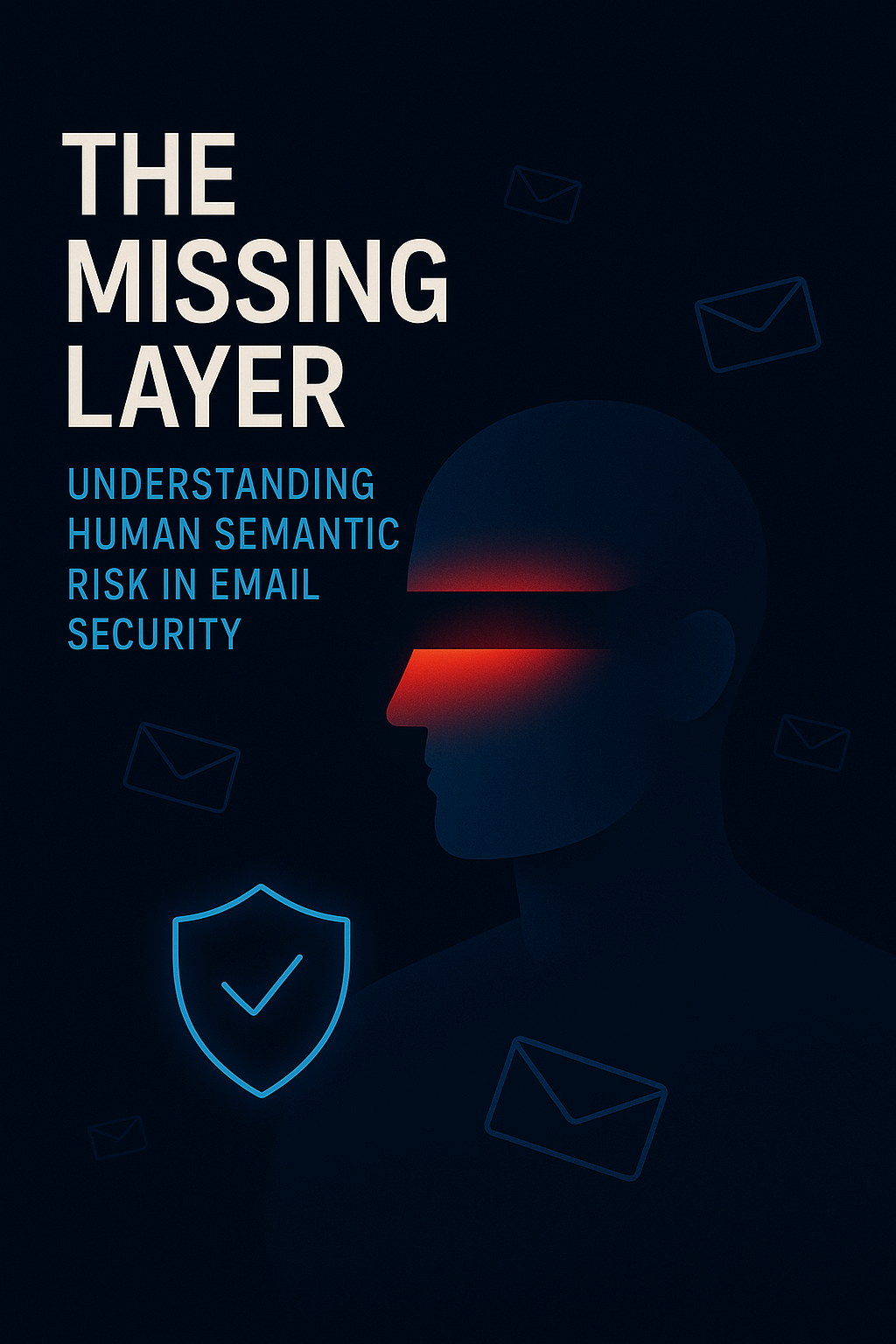
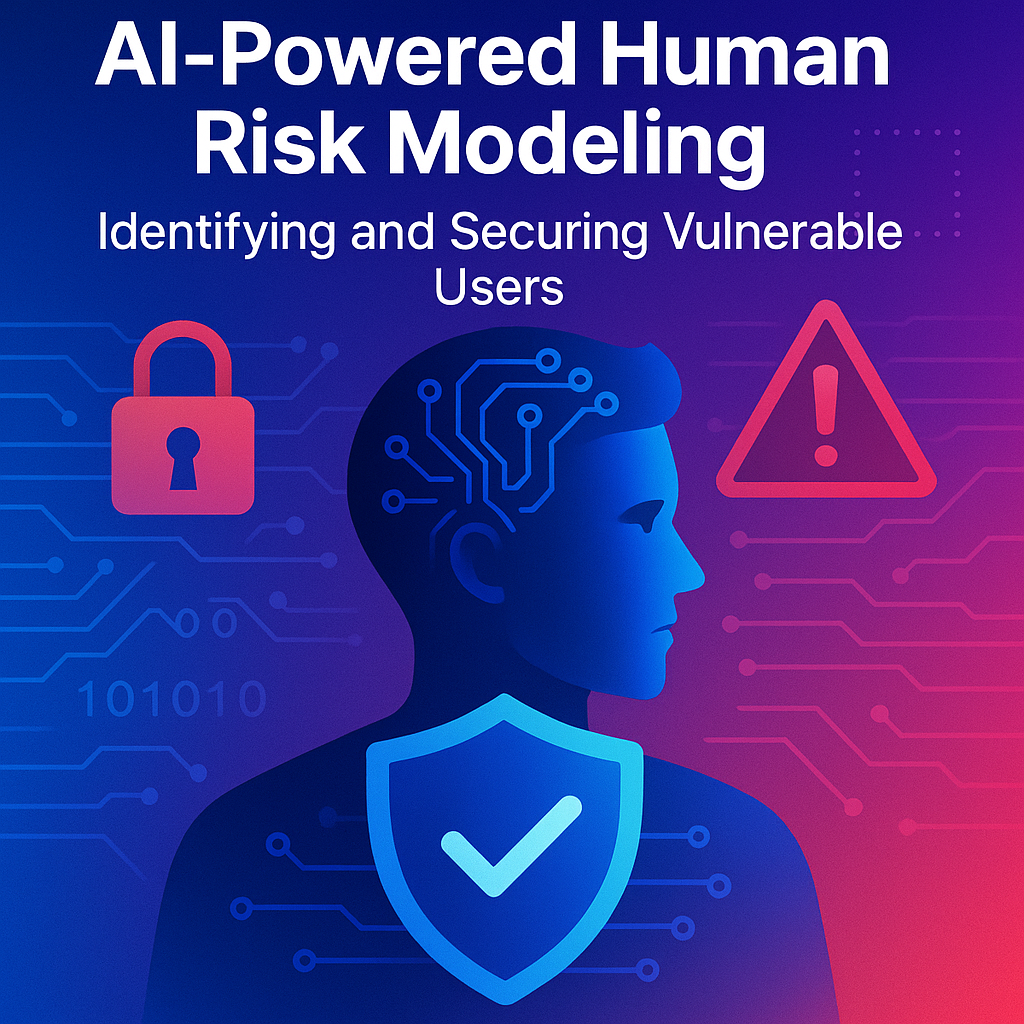
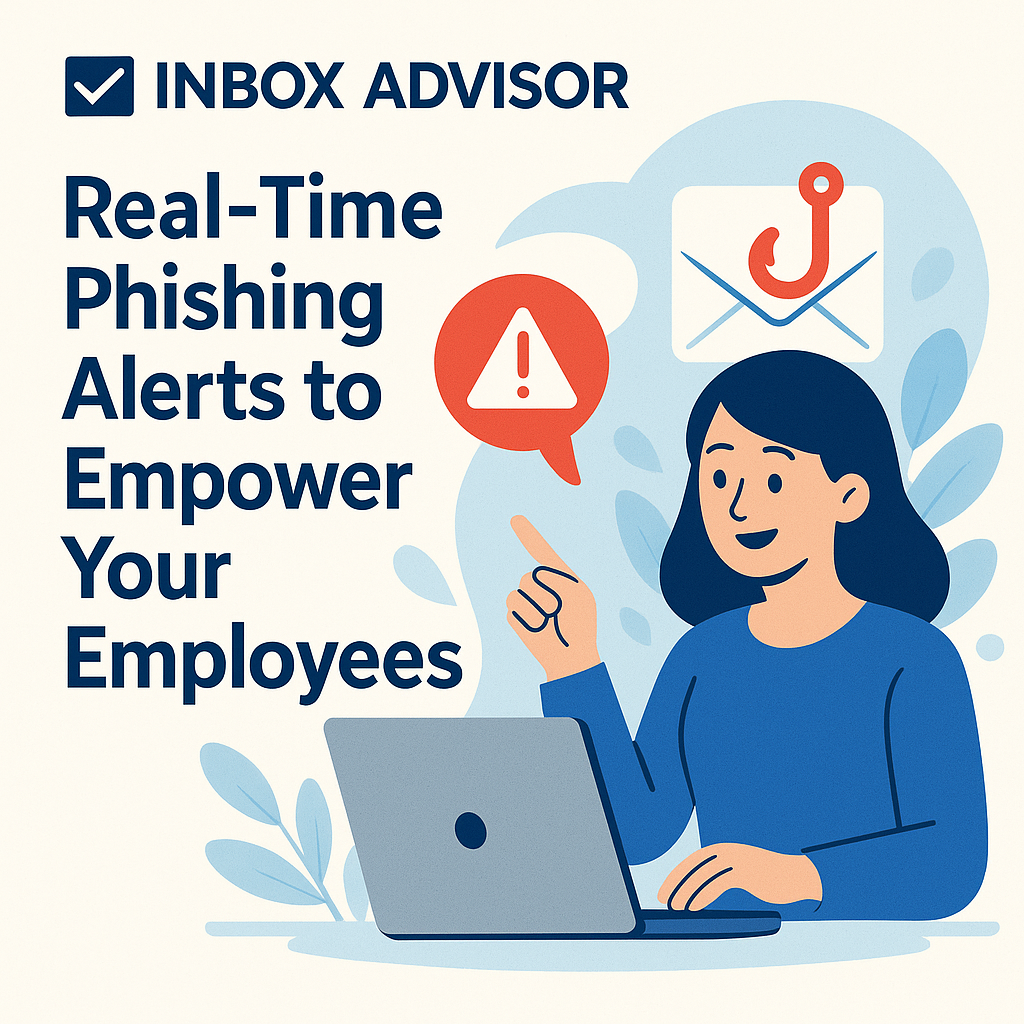



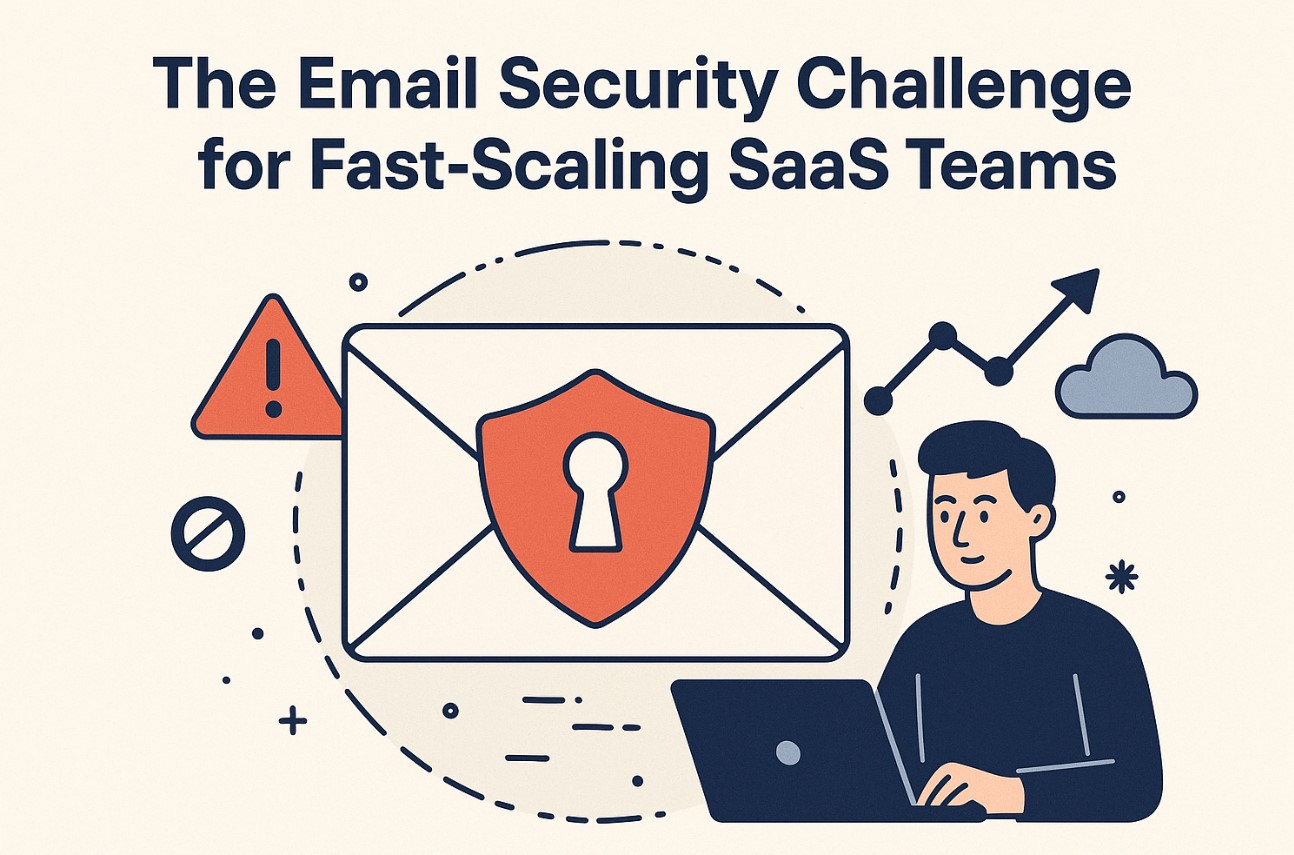
.png)

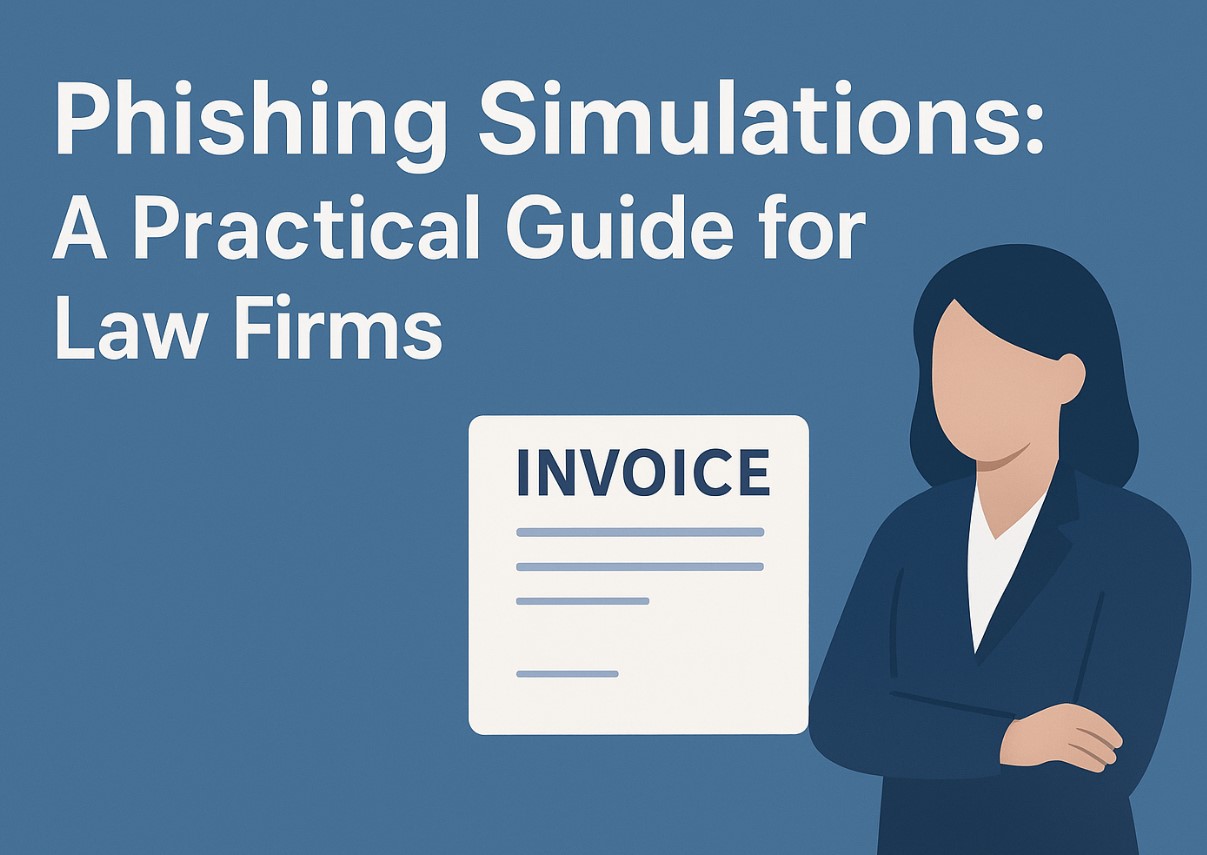


.png)
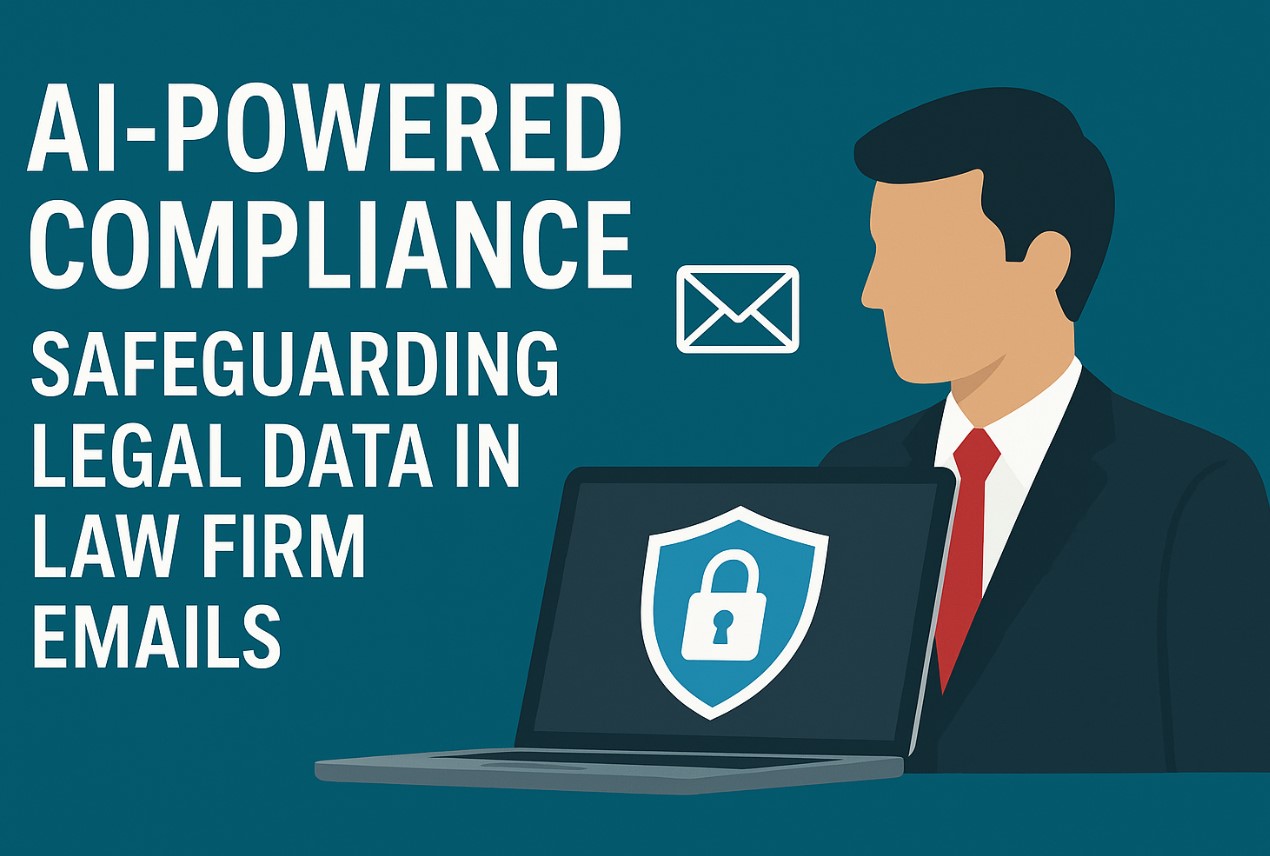
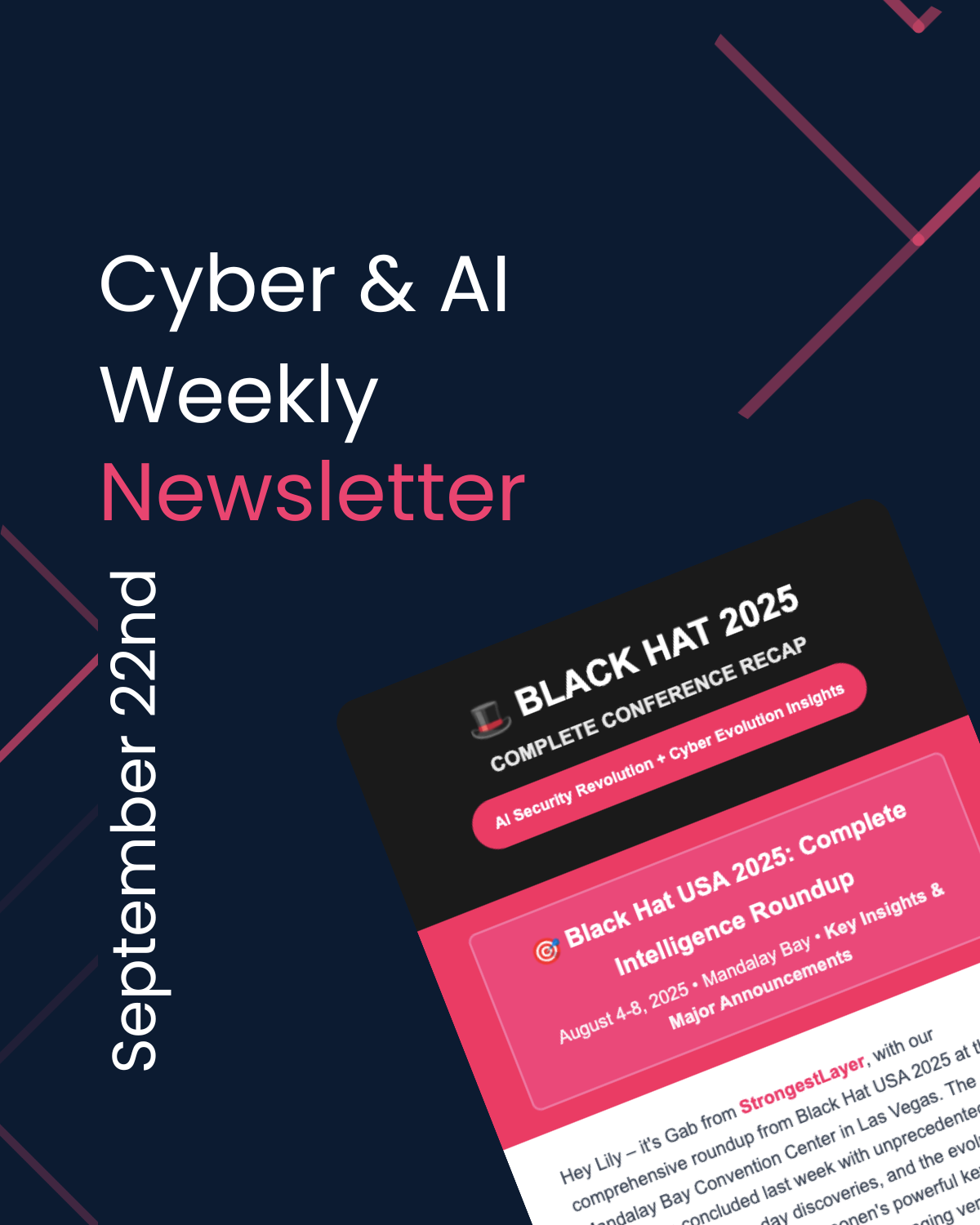
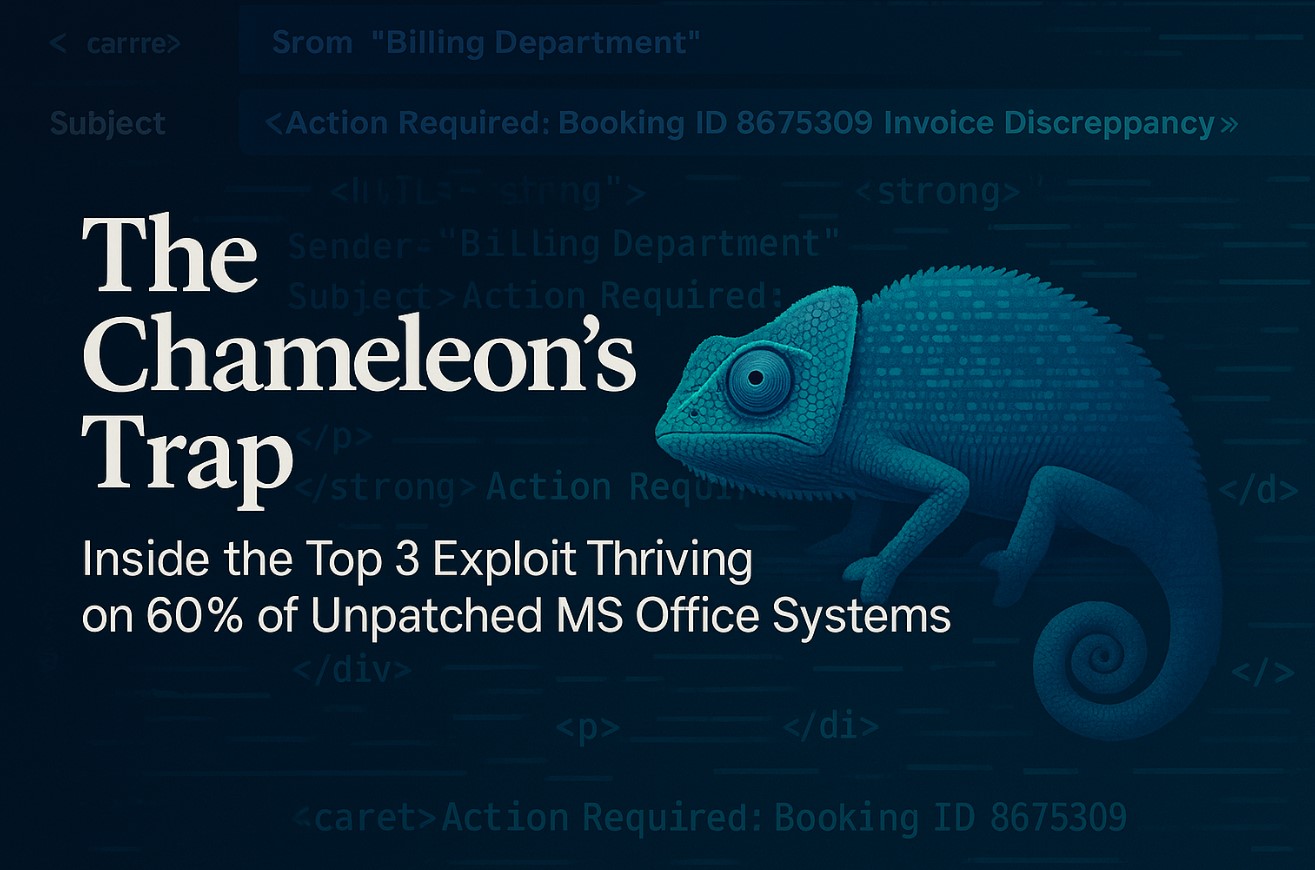

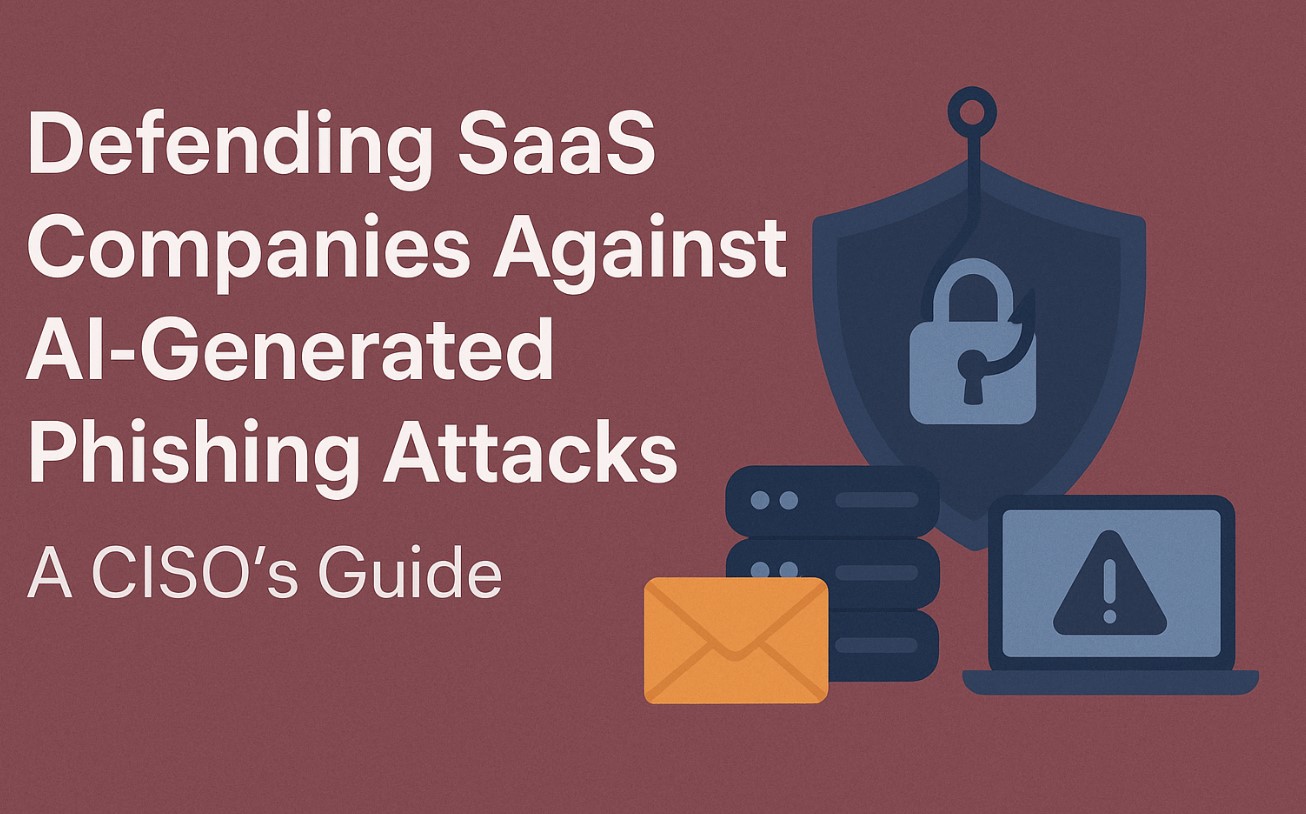


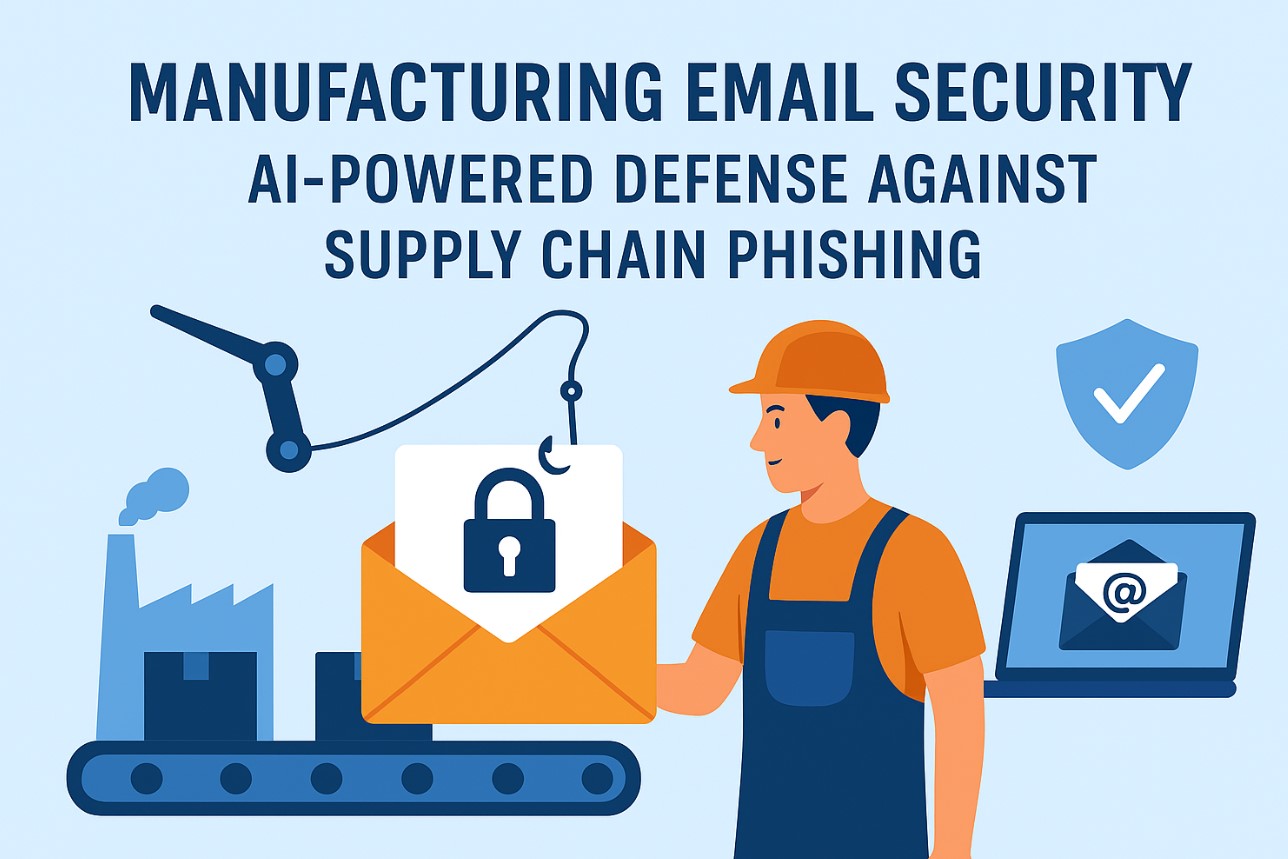
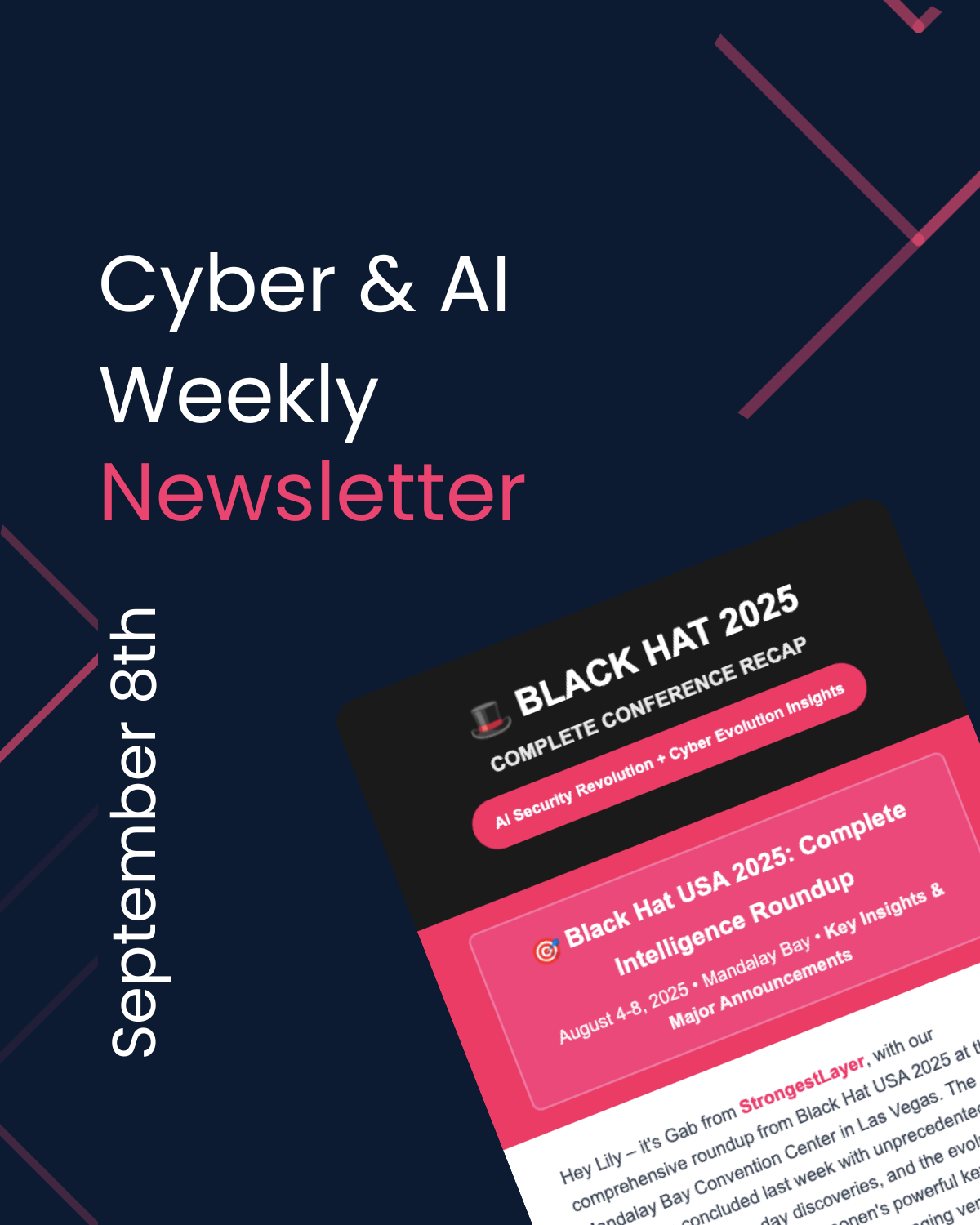


.png)

.png)
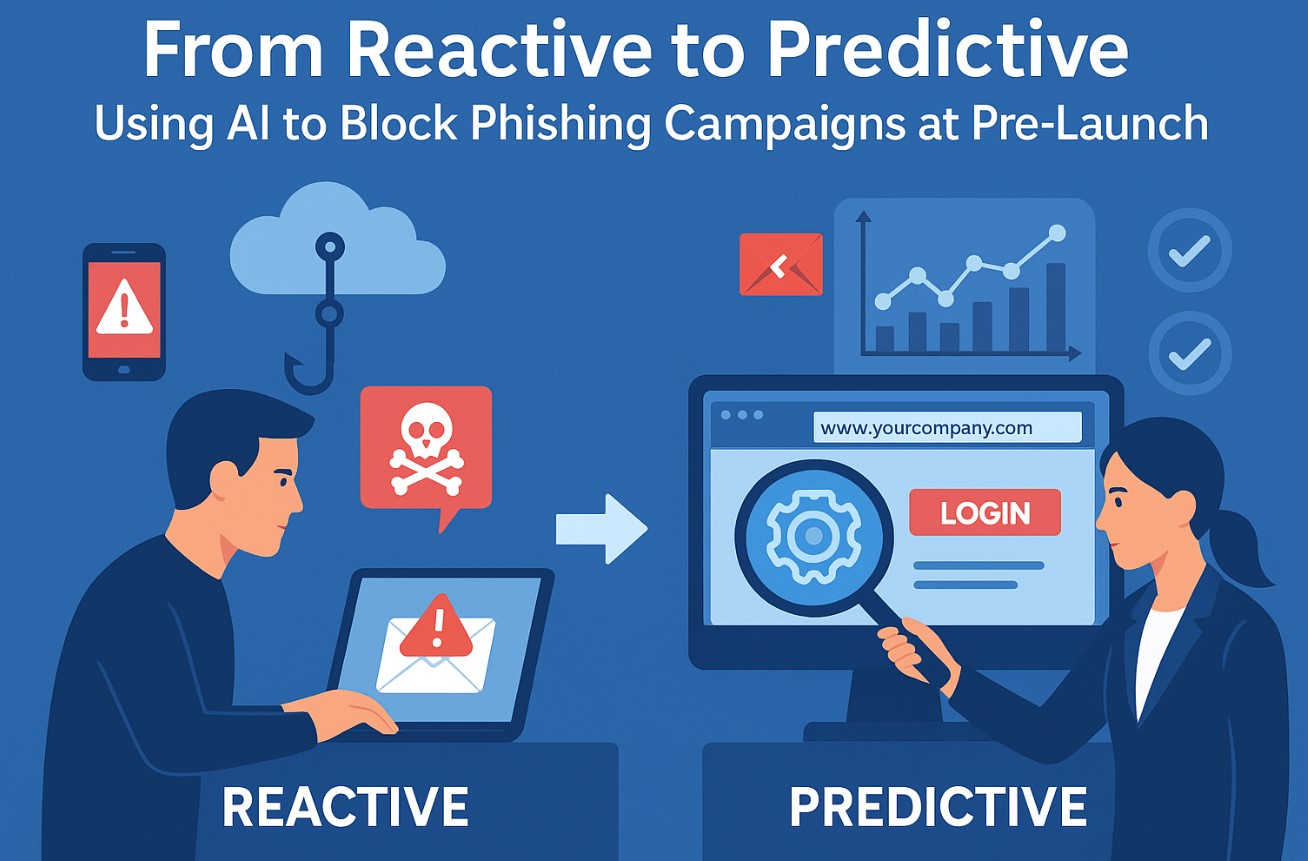


.png)
.jpg)
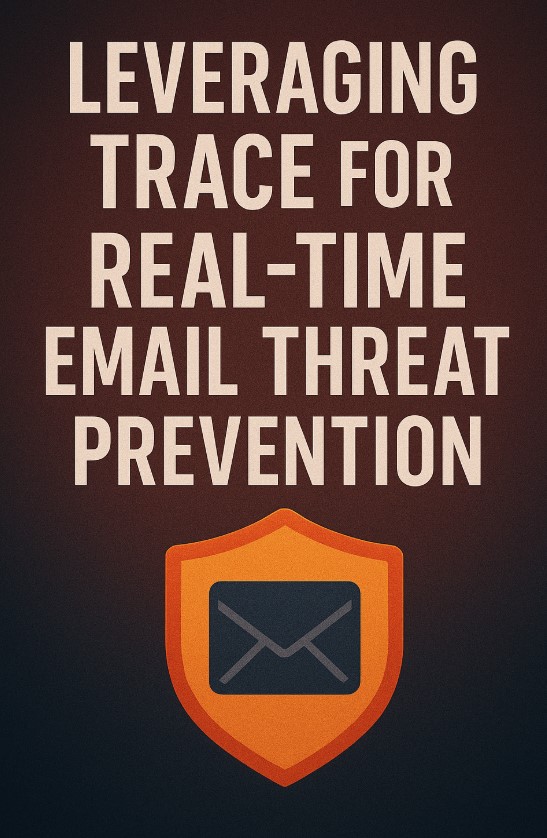
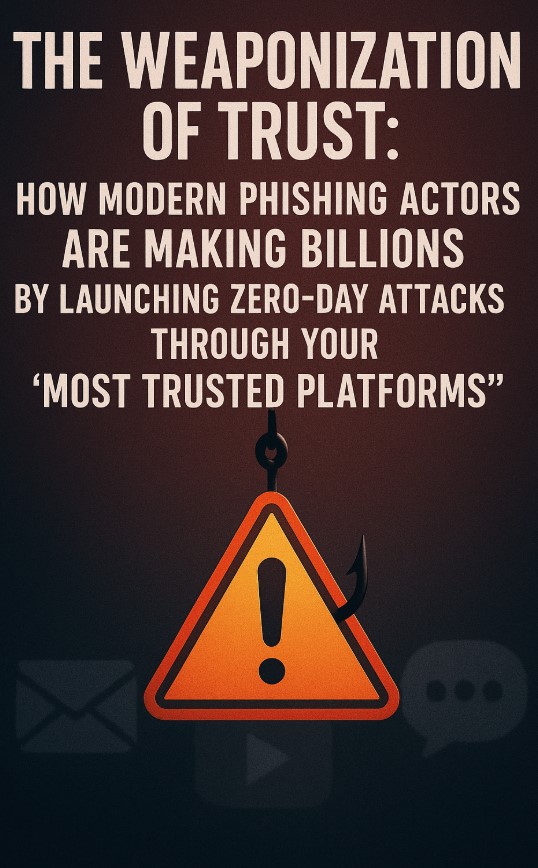
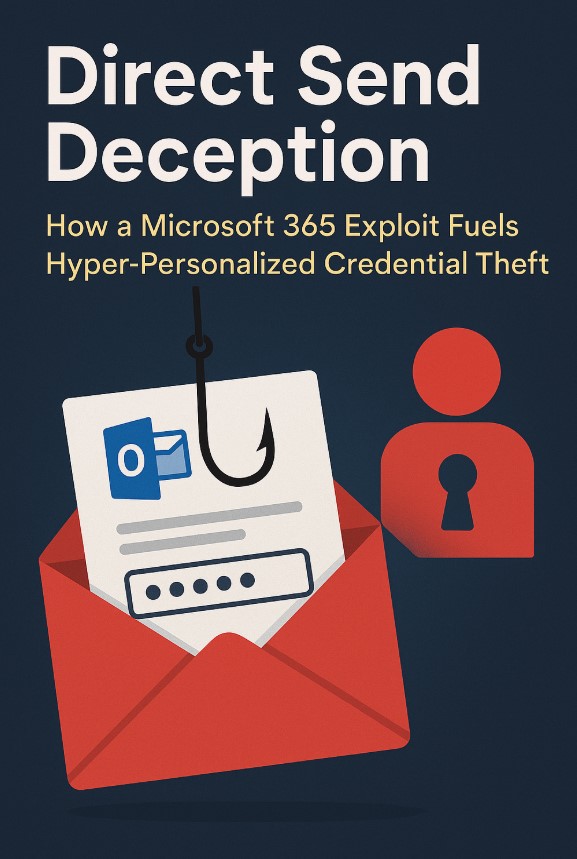
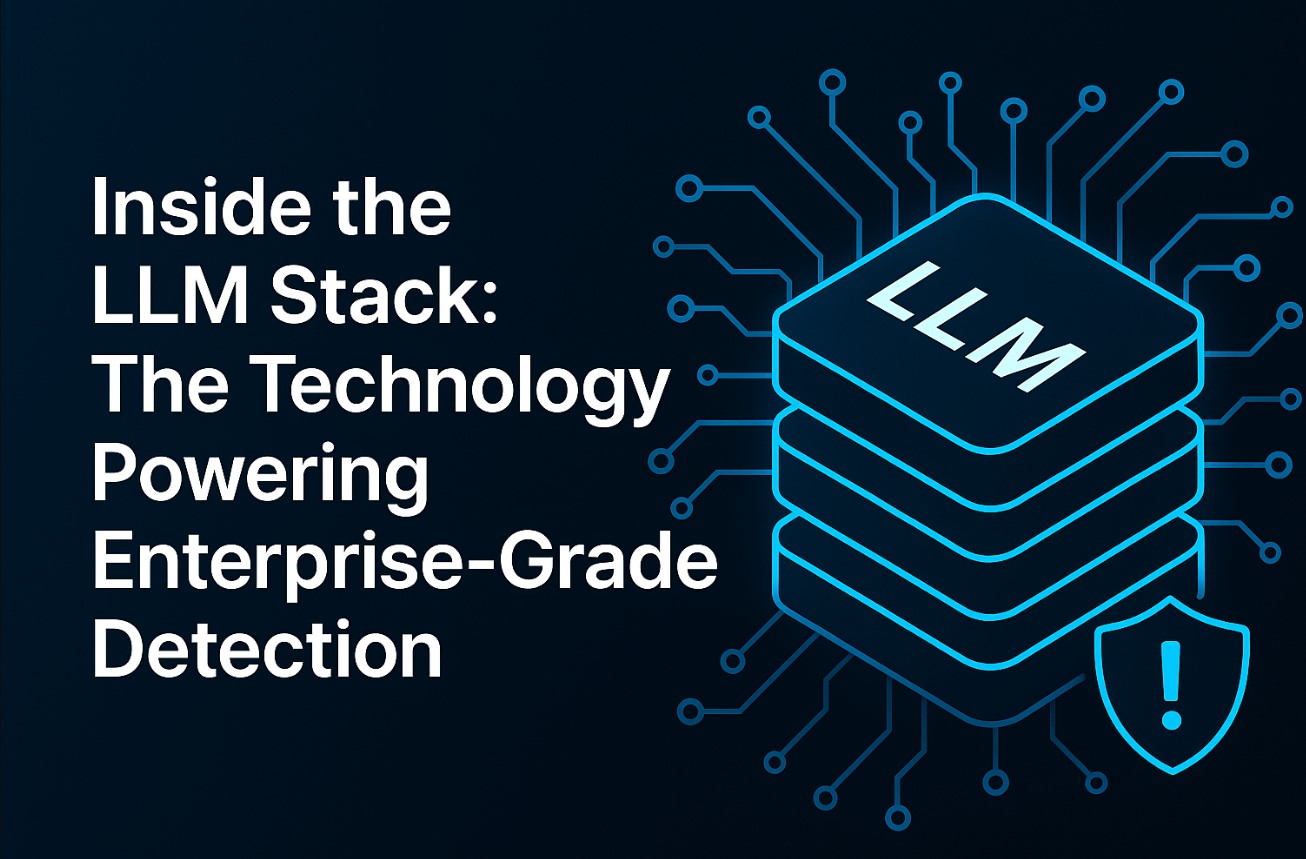
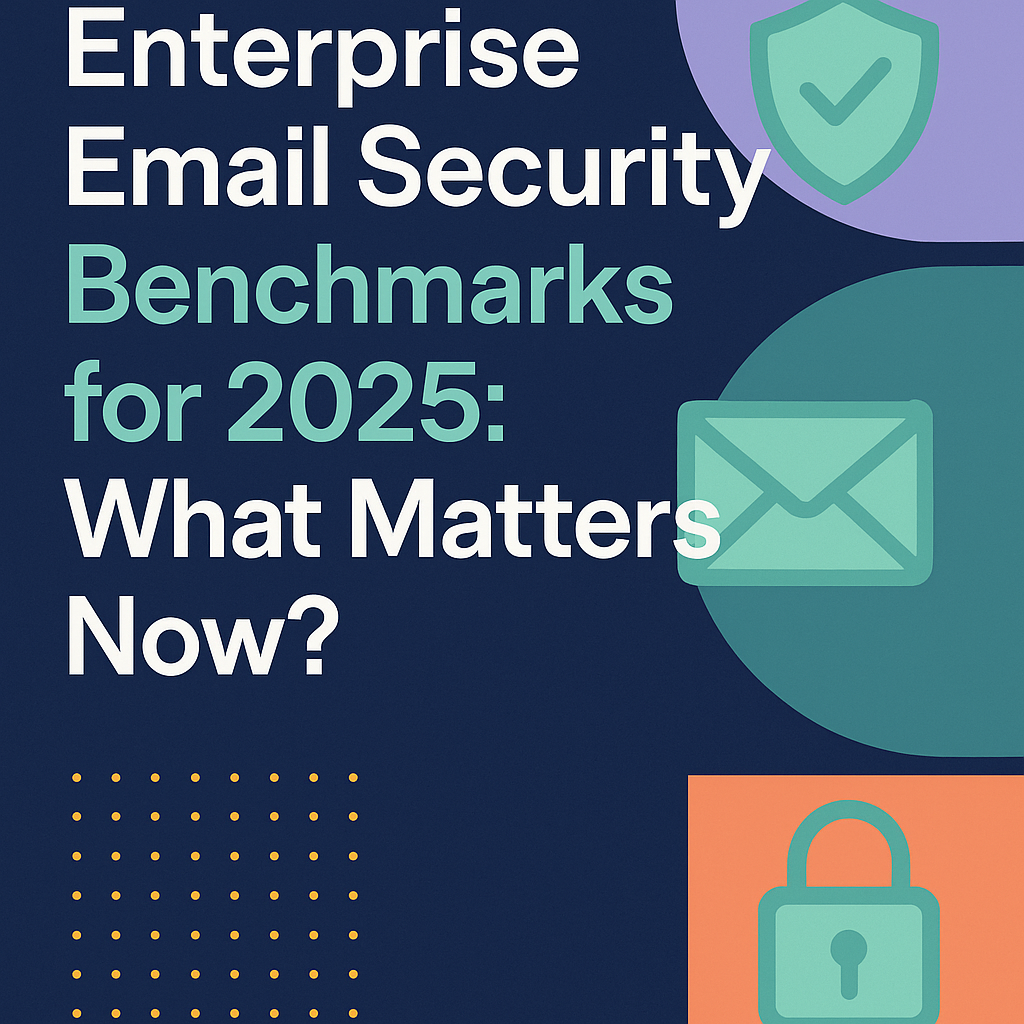
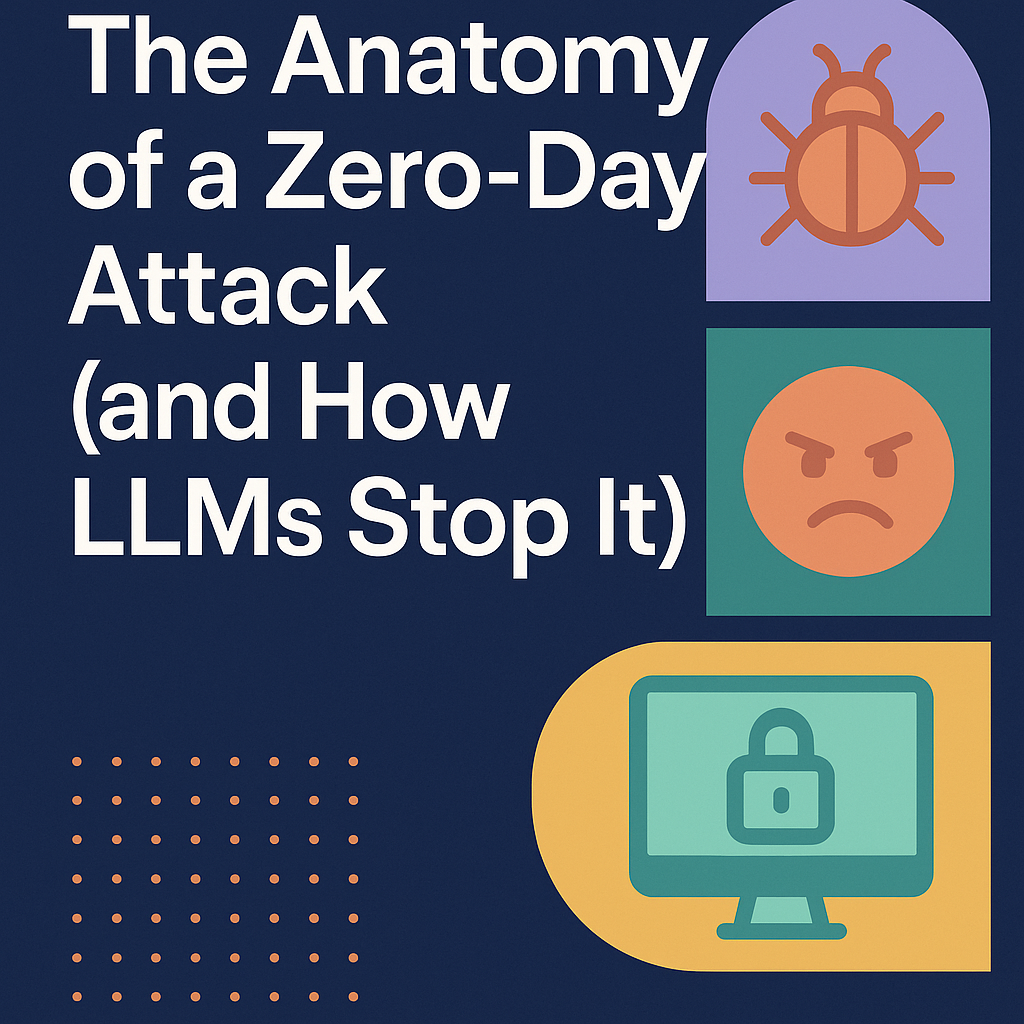
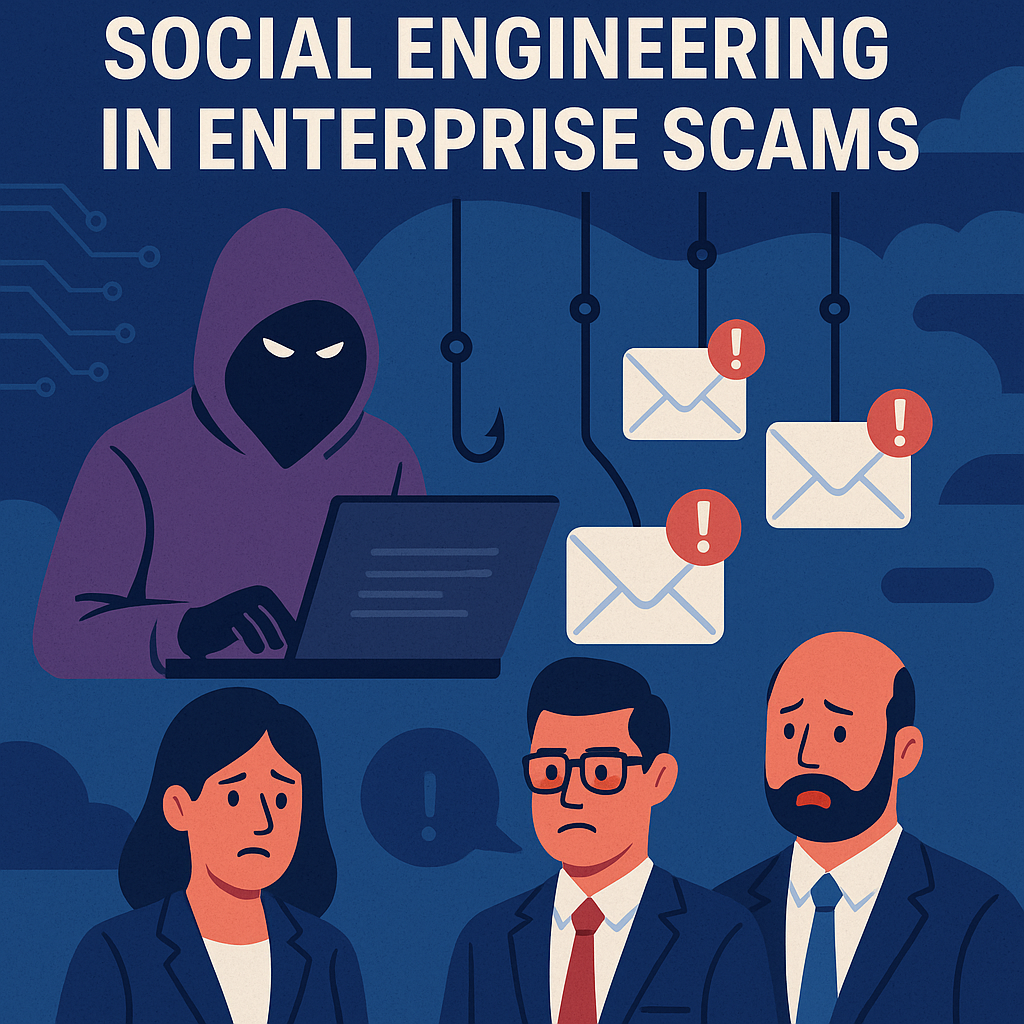
.png)







.png)































%20Attacks%20in%202025.jpg)









